Pharmacy Consultation Notes Example
VerifiedAdded on 2020/01/07
|30
|7225
|216
Project
AI Summary
This assignment provides example pharmacy consultation notes for a patient experiencing migraines and thyroid-related health concerns. The notes outline the pharmacist's interactions with the patient, including medication reviews, lifestyle recommendations to manage existing health conditions, and a plan for future follow-up. The document emphasizes the pharmacist's role in providing comprehensive patient care beyond dispensing medications.
Contribute Materials
Your contribution can guide someone’s learning journey. Share your
documents today.
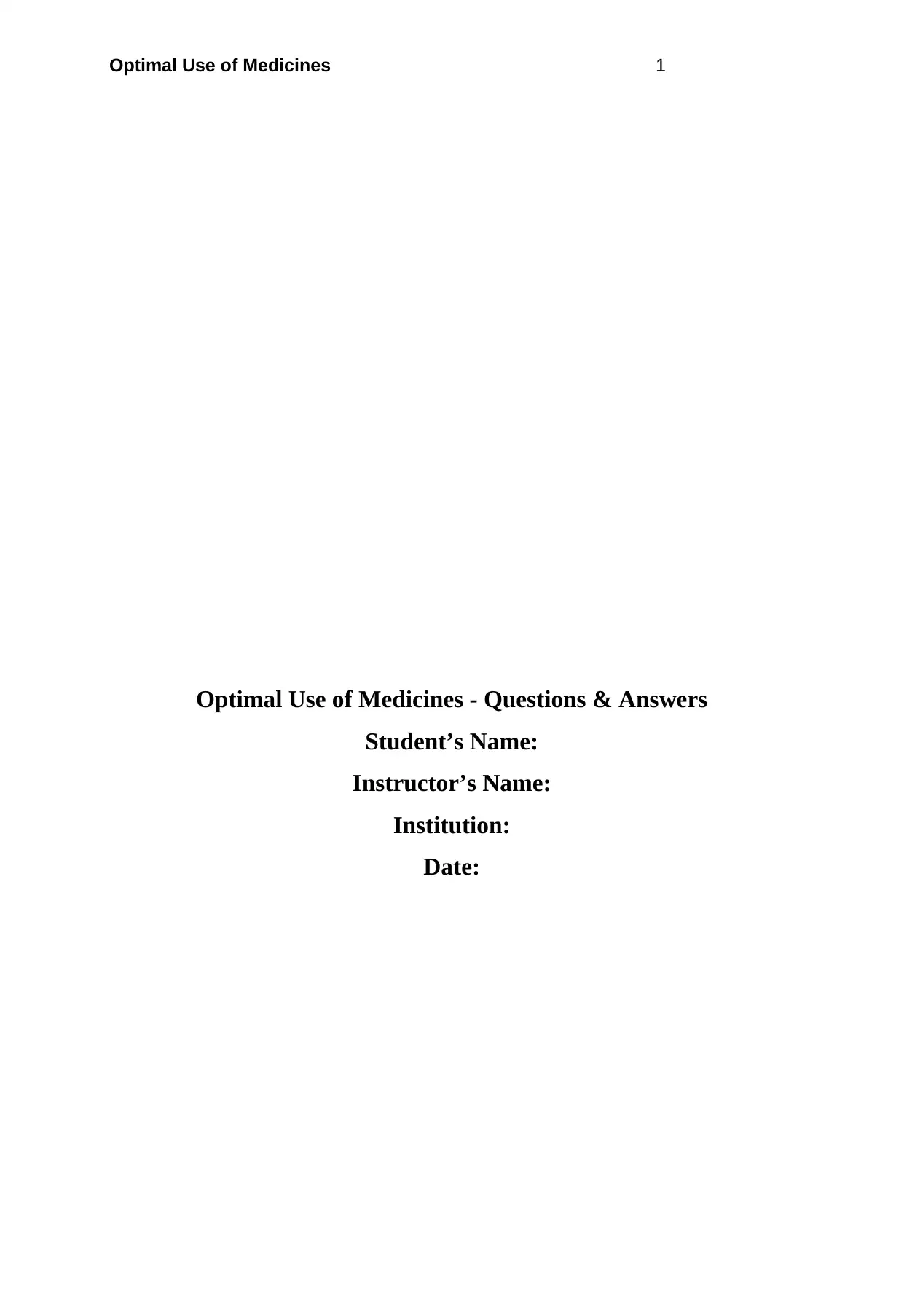
Optimal Use of Medicines 1
Optimal Use of Medicines - Questions & Answers
Student’s Name:
Instructor’s Name:
Institution:
Date:
Optimal Use of Medicines - Questions & Answers
Student’s Name:
Instructor’s Name:
Institution:
Date:
Secure Best Marks with AI Grader
Need help grading? Try our AI Grader for instant feedback on your assignments.
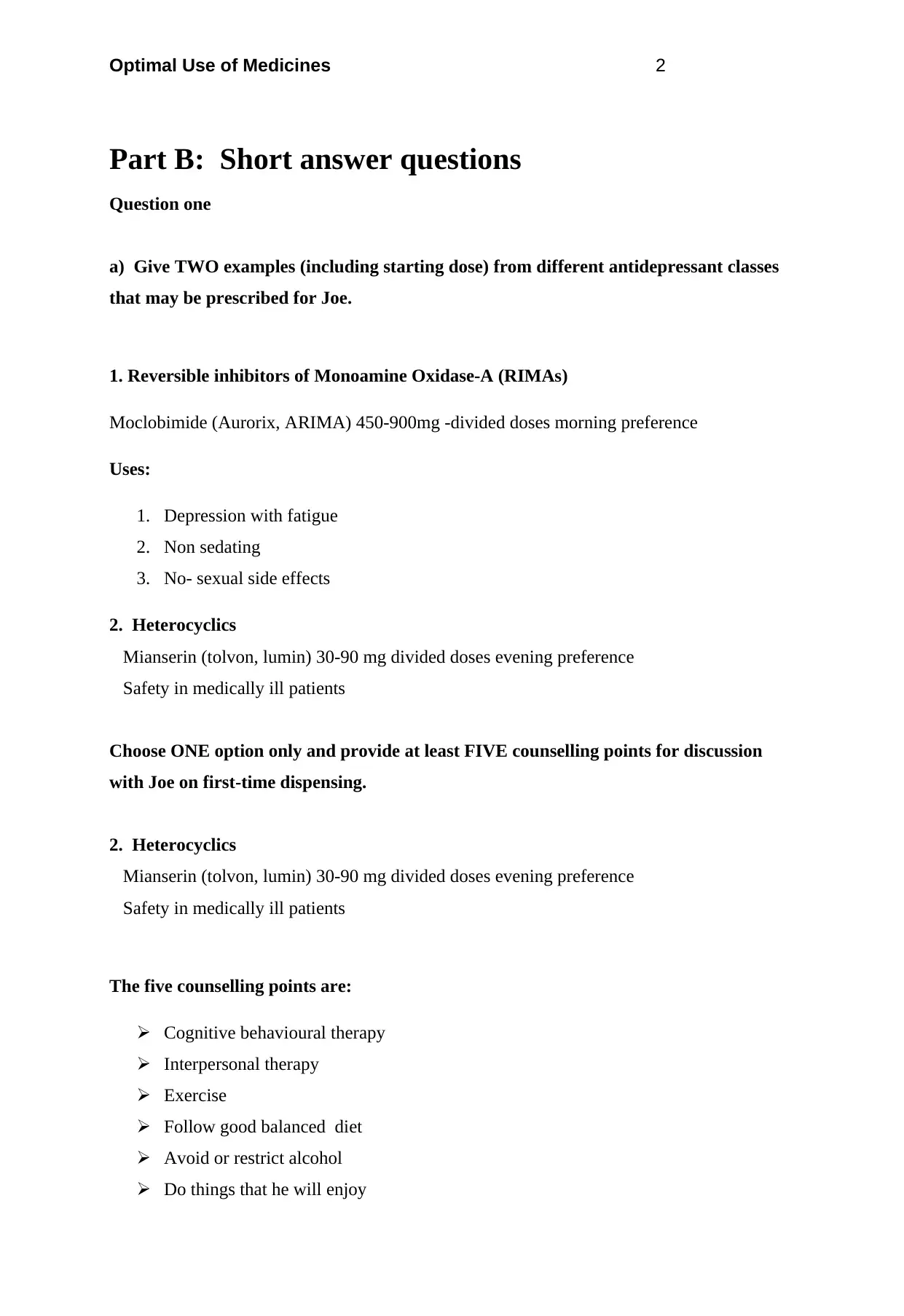
Optimal Use of Medicines 2
Part B: Short answer questions
Question one
a) Give TWO examples (including starting dose) from different antidepressant classes
that may be prescribed for Joe.
1. Reversible inhibitors of Monoamine Oxidase-A (RIMAs)
Moclobimide (Aurorix, ARIMA) 450-900mg -divided doses morning preference
Uses:
1. Depression with fatigue
2. Non sedating
3. No- sexual side effects
2. Heterocyclics
Mianserin (tolvon, lumin) 30-90 mg divided doses evening preference
Safety in medically ill patients
Choose ONE option only and provide at least FIVE counselling points for discussion
with Joe on first-time dispensing.
2. Heterocyclics
Mianserin (tolvon, lumin) 30-90 mg divided doses evening preference
Safety in medically ill patients
The five counselling points are:
Cognitive behavioural therapy
Interpersonal therapy
Exercise
Follow good balanced diet
Avoid or restrict alcohol
Do things that he will enjoy
Part B: Short answer questions
Question one
a) Give TWO examples (including starting dose) from different antidepressant classes
that may be prescribed for Joe.
1. Reversible inhibitors of Monoamine Oxidase-A (RIMAs)
Moclobimide (Aurorix, ARIMA) 450-900mg -divided doses morning preference
Uses:
1. Depression with fatigue
2. Non sedating
3. No- sexual side effects
2. Heterocyclics
Mianserin (tolvon, lumin) 30-90 mg divided doses evening preference
Safety in medically ill patients
Choose ONE option only and provide at least FIVE counselling points for discussion
with Joe on first-time dispensing.
2. Heterocyclics
Mianserin (tolvon, lumin) 30-90 mg divided doses evening preference
Safety in medically ill patients
The five counselling points are:
Cognitive behavioural therapy
Interpersonal therapy
Exercise
Follow good balanced diet
Avoid or restrict alcohol
Do things that he will enjoy
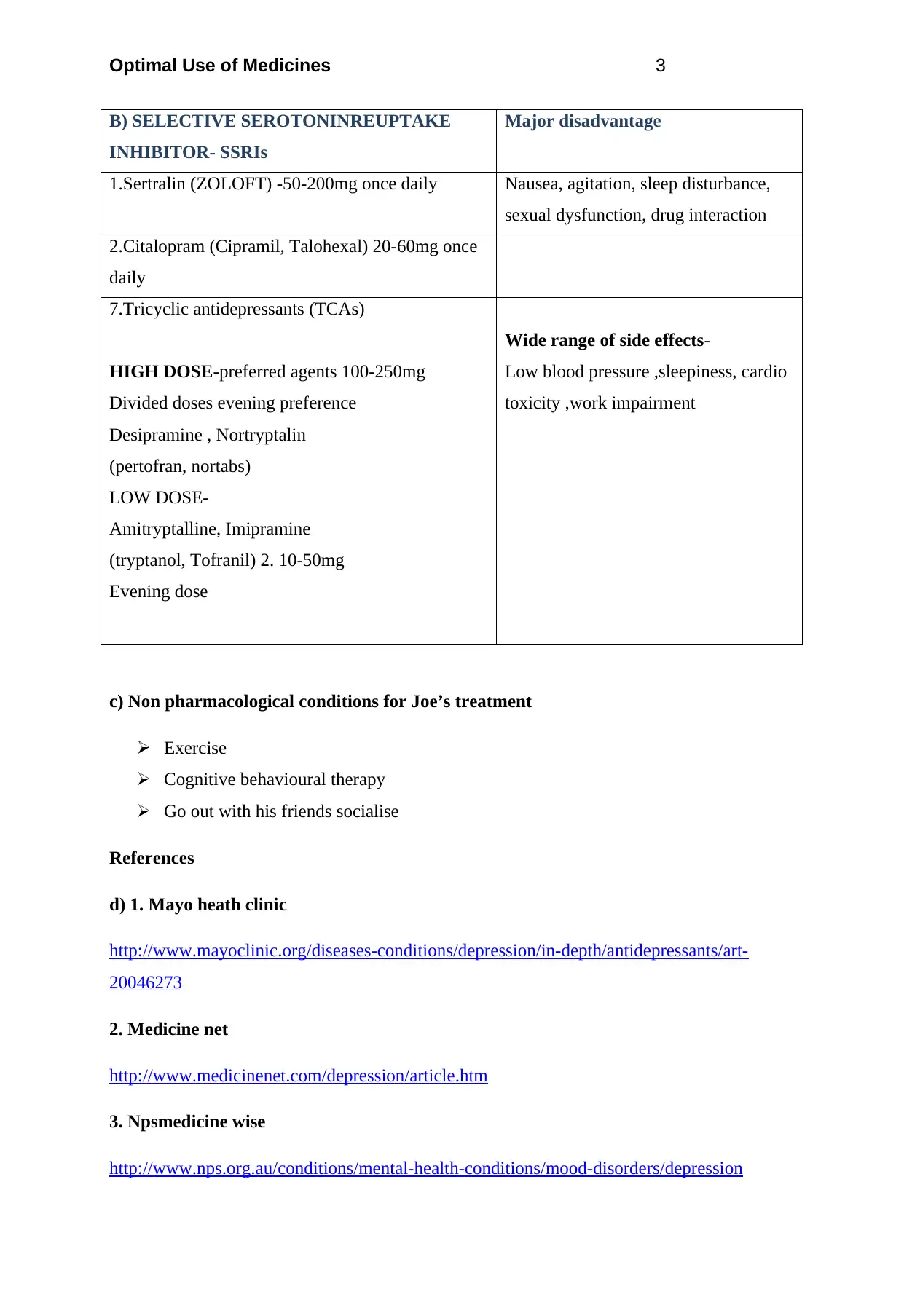
Optimal Use of Medicines 3
B) SELECTIVE SEROTONINREUPTAKE
INHIBITOR- SSRIs
Major disadvantage
1.Sertralin (ZOLOFT) -50-200mg once daily Nausea, agitation, sleep disturbance,
sexual dysfunction, drug interaction
2.Citalopram (Cipramil, Talohexal) 20-60mg once
daily
7.Tricyclic antidepressants (TCAs)
HIGH DOSE-preferred agents 100-250mg
Divided doses evening preference
Desipramine , Nortryptalin
(pertofran, nortabs)
LOW DOSE-
Amitryptalline, Imipramine
(tryptanol, Tofranil) 2. 10-50mg
Evening dose
Wide range of side effects-
Low blood pressure ,sleepiness, cardio
toxicity ,work impairment
c) Non pharmacological conditions for Joe’s treatment
Exercise
Cognitive behavioural therapy
Go out with his friends socialise
References
d) 1. Mayo heath clinic
http://www.mayoclinic.org/diseases-conditions/depression/in-depth/antidepressants/art-
20046273
2. Medicine net
http://www.medicinenet.com/depression/article.htm
3. Npsmedicine wise
http://www.nps.org.au/conditions/mental-health-conditions/mood-disorders/depression
B) SELECTIVE SEROTONINREUPTAKE
INHIBITOR- SSRIs
Major disadvantage
1.Sertralin (ZOLOFT) -50-200mg once daily Nausea, agitation, sleep disturbance,
sexual dysfunction, drug interaction
2.Citalopram (Cipramil, Talohexal) 20-60mg once
daily
7.Tricyclic antidepressants (TCAs)
HIGH DOSE-preferred agents 100-250mg
Divided doses evening preference
Desipramine , Nortryptalin
(pertofran, nortabs)
LOW DOSE-
Amitryptalline, Imipramine
(tryptanol, Tofranil) 2. 10-50mg
Evening dose
Wide range of side effects-
Low blood pressure ,sleepiness, cardio
toxicity ,work impairment
c) Non pharmacological conditions for Joe’s treatment
Exercise
Cognitive behavioural therapy
Go out with his friends socialise
References
d) 1. Mayo heath clinic
http://www.mayoclinic.org/diseases-conditions/depression/in-depth/antidepressants/art-
20046273
2. Medicine net
http://www.medicinenet.com/depression/article.htm
3. Npsmedicine wise
http://www.nps.org.au/conditions/mental-health-conditions/mood-disorders/depression
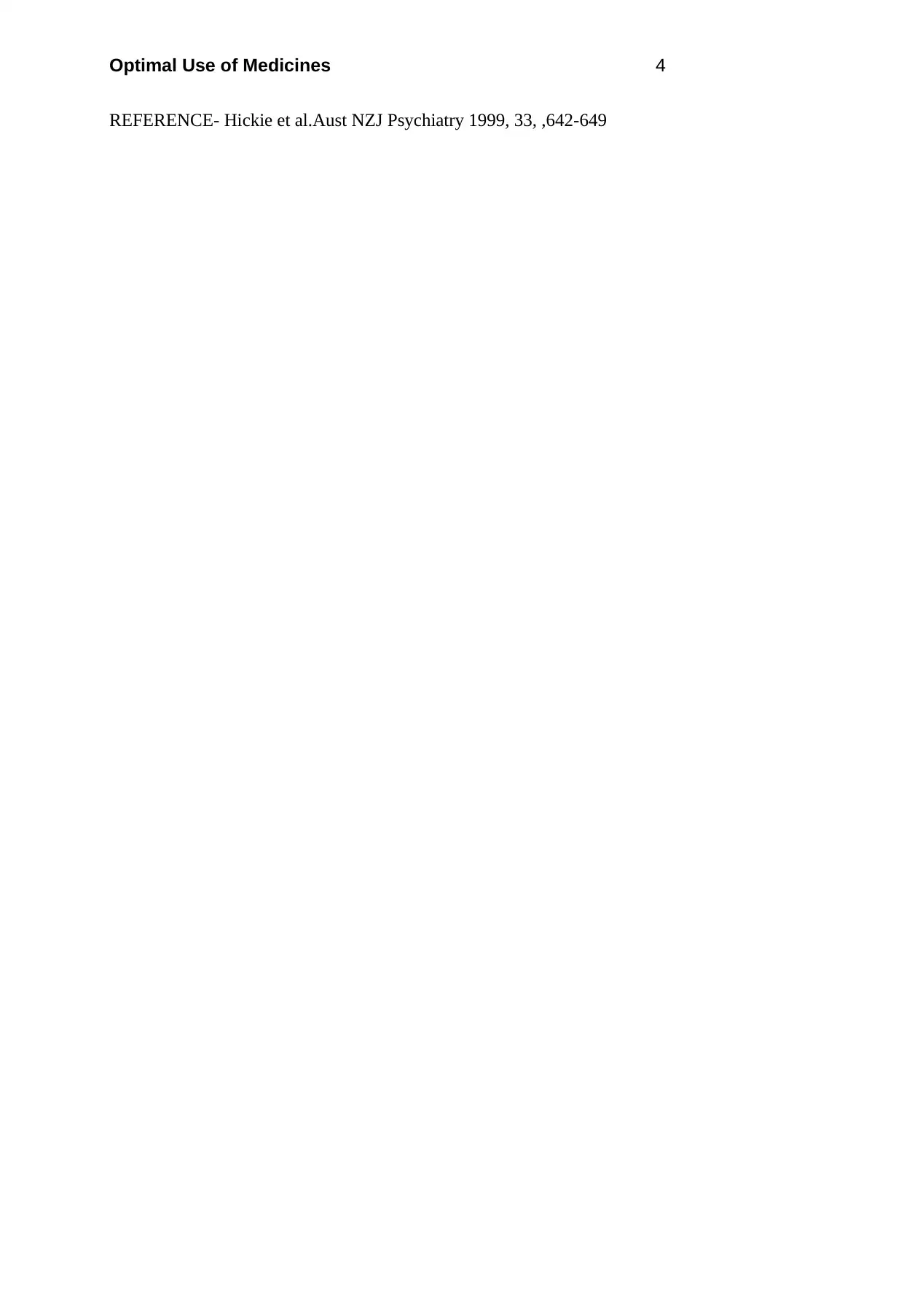
Optimal Use of Medicines 4
REFERENCE- Hickie et al.Aust NZJ Psychiatry 1999, 33, ,642-649
REFERENCE- Hickie et al.Aust NZJ Psychiatry 1999, 33, ,642-649
Secure Best Marks with AI Grader
Need help grading? Try our AI Grader for instant feedback on your assignments.
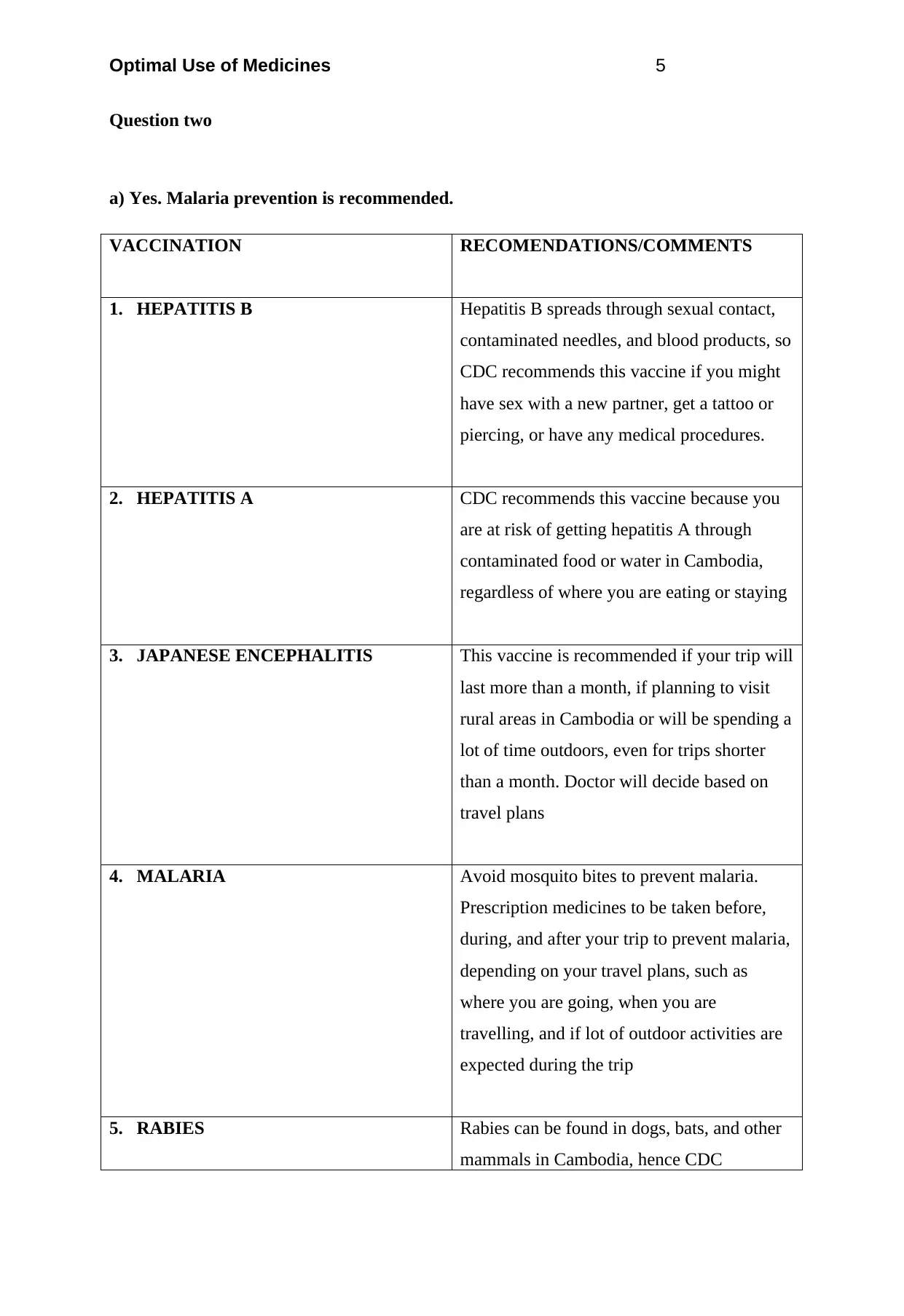
Optimal Use of Medicines 5
Question two
a) Yes. Malaria prevention is recommended.
VACCINATION RECOMENDATIONS/COMMENTS
1. HEPATITIS B Hepatitis B spreads through sexual contact,
contaminated needles, and blood products, so
CDC recommends this vaccine if you might
have sex with a new partner, get a tattoo or
piercing, or have any medical procedures.
2. HEPATITIS A CDC recommends this vaccine because you
are at risk of getting hepatitis A through
contaminated food or water in Cambodia,
regardless of where you are eating or staying
3. JAPANESE ENCEPHALITIS This vaccine is recommended if your trip will
last more than a month, if planning to visit
rural areas in Cambodia or will be spending a
lot of time outdoors, even for trips shorter
than a month. Doctor will decide based on
travel plans
4. MALARIA Avoid mosquito bites to prevent malaria.
Prescription medicines to be taken before,
during, and after your trip to prevent malaria,
depending on your travel plans, such as
where you are going, when you are
travelling, and if lot of outdoor activities are
expected during the trip
5. RABIES Rabies can be found in dogs, bats, and other
mammals in Cambodia, hence CDC
Question two
a) Yes. Malaria prevention is recommended.
VACCINATION RECOMENDATIONS/COMMENTS
1. HEPATITIS B Hepatitis B spreads through sexual contact,
contaminated needles, and blood products, so
CDC recommends this vaccine if you might
have sex with a new partner, get a tattoo or
piercing, or have any medical procedures.
2. HEPATITIS A CDC recommends this vaccine because you
are at risk of getting hepatitis A through
contaminated food or water in Cambodia,
regardless of where you are eating or staying
3. JAPANESE ENCEPHALITIS This vaccine is recommended if your trip will
last more than a month, if planning to visit
rural areas in Cambodia or will be spending a
lot of time outdoors, even for trips shorter
than a month. Doctor will decide based on
travel plans
4. MALARIA Avoid mosquito bites to prevent malaria.
Prescription medicines to be taken before,
during, and after your trip to prevent malaria,
depending on your travel plans, such as
where you are going, when you are
travelling, and if lot of outdoor activities are
expected during the trip
5. RABIES Rabies can be found in dogs, bats, and other
mammals in Cambodia, hence CDC
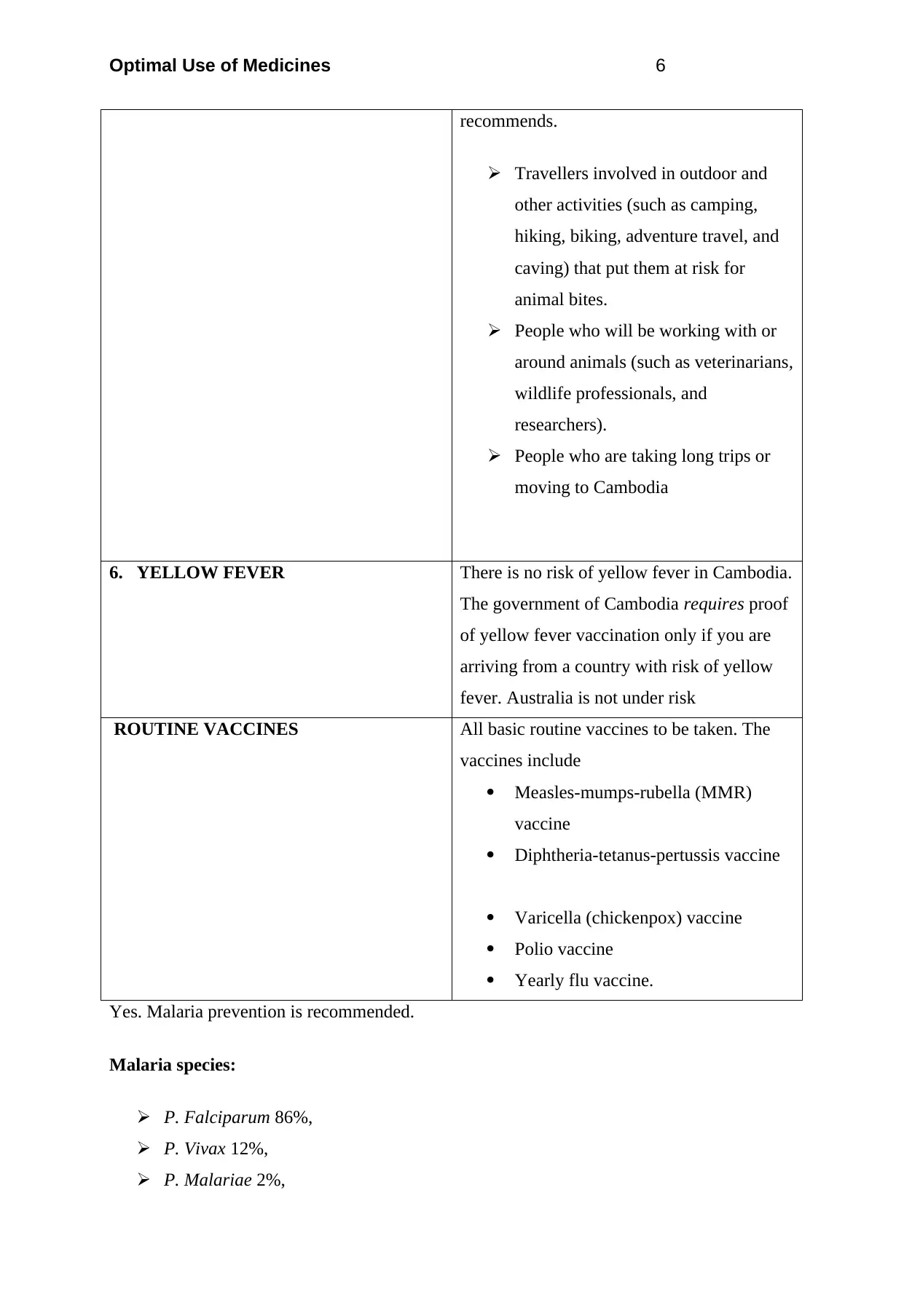
Optimal Use of Medicines 6
recommends.
Travellers involved in outdoor and
other activities (such as camping,
hiking, biking, adventure travel, and
caving) that put them at risk for
animal bites.
People who will be working with or
around animals (such as veterinarians,
wildlife professionals, and
researchers).
People who are taking long trips or
moving to Cambodia
6. YELLOW FEVER There is no risk of yellow fever in Cambodia.
The government of Cambodia requires proof
of yellow fever vaccination only if you are
arriving from a country with risk of yellow
fever. Australia is not under risk
ROUTINE VACCINES All basic routine vaccines to be taken. The
vaccines include
Measles-mumps-rubella (MMR)
vaccine
Diphtheria-tetanus-pertussis vaccine
Varicella (chickenpox) vaccine
Polio vaccine
Yearly flu vaccine.
Yes. Malaria prevention is recommended.
Malaria species:
P. Falciparum 86%,
P. Vivax 12%,
P. Malariae 2%,
recommends.
Travellers involved in outdoor and
other activities (such as camping,
hiking, biking, adventure travel, and
caving) that put them at risk for
animal bites.
People who will be working with or
around animals (such as veterinarians,
wildlife professionals, and
researchers).
People who are taking long trips or
moving to Cambodia
6. YELLOW FEVER There is no risk of yellow fever in Cambodia.
The government of Cambodia requires proof
of yellow fever vaccination only if you are
arriving from a country with risk of yellow
fever. Australia is not under risk
ROUTINE VACCINES All basic routine vaccines to be taken. The
vaccines include
Measles-mumps-rubella (MMR)
vaccine
Diphtheria-tetanus-pertussis vaccine
Varicella (chickenpox) vaccine
Polio vaccine
Yearly flu vaccine.
Yes. Malaria prevention is recommended.
Malaria species:
P. Falciparum 86%,
P. Vivax 12%,
P. Malariae 2%,
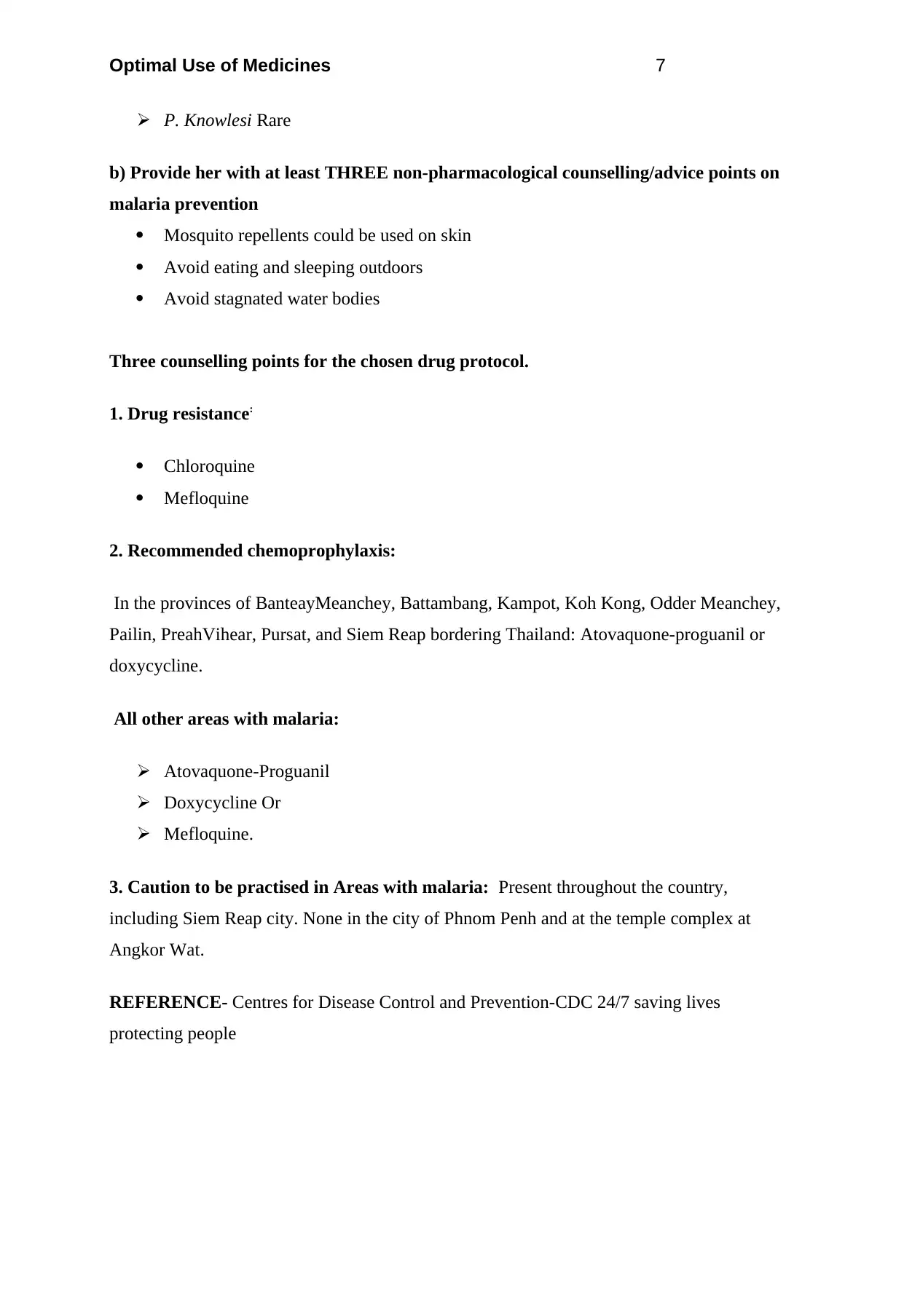
Optimal Use of Medicines 7
P. Knowlesi Rare
b) Provide her with at least THREE non-pharmacological counselling/advice points on
malaria prevention
Mosquito repellents could be used on skin
Avoid eating and sleeping outdoors
Avoid stagnated water bodies
Three counselling points for the chosen drug protocol.
1. Drug resistance:
Chloroquine
Mefloquine
2. Recommended chemoprophylaxis:
In the provinces of BanteayMeanchey, Battambang, Kampot, Koh Kong, Odder Meanchey,
Pailin, PreahVihear, Pursat, and Siem Reap bordering Thailand: Atovaquone-proguanil or
doxycycline.
All other areas with malaria:
Atovaquone-Proguanil
Doxycycline Or
Mefloquine.
3. Caution to be practised in Areas with malaria: Present throughout the country,
including Siem Reap city. None in the city of Phnom Penh and at the temple complex at
Angkor Wat.
REFERENCE- Centres for Disease Control and Prevention-CDC 24/7 saving lives
protecting people
P. Knowlesi Rare
b) Provide her with at least THREE non-pharmacological counselling/advice points on
malaria prevention
Mosquito repellents could be used on skin
Avoid eating and sleeping outdoors
Avoid stagnated water bodies
Three counselling points for the chosen drug protocol.
1. Drug resistance:
Chloroquine
Mefloquine
2. Recommended chemoprophylaxis:
In the provinces of BanteayMeanchey, Battambang, Kampot, Koh Kong, Odder Meanchey,
Pailin, PreahVihear, Pursat, and Siem Reap bordering Thailand: Atovaquone-proguanil or
doxycycline.
All other areas with malaria:
Atovaquone-Proguanil
Doxycycline Or
Mefloquine.
3. Caution to be practised in Areas with malaria: Present throughout the country,
including Siem Reap city. None in the city of Phnom Penh and at the temple complex at
Angkor Wat.
REFERENCE- Centres for Disease Control and Prevention-CDC 24/7 saving lives
protecting people
Paraphrase This Document
Need a fresh take? Get an instant paraphrase of this document with our AI Paraphraser
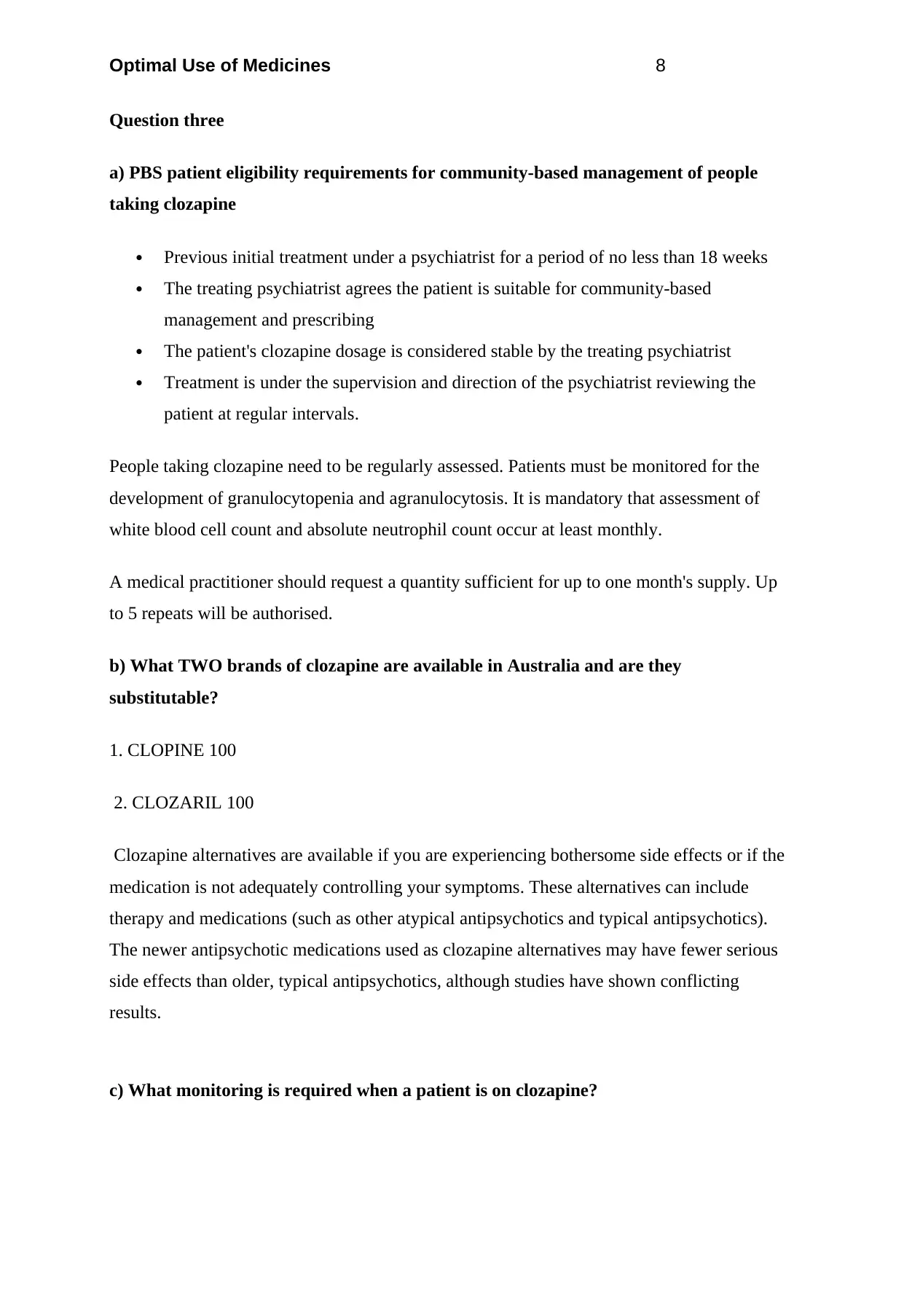
Optimal Use of Medicines 8
Question three
a) PBS patient eligibility requirements for community-based management of people
taking clozapine
Previous initial treatment under a psychiatrist for a period of no less than 18 weeks
The treating psychiatrist agrees the patient is suitable for community-based
management and prescribing
The patient's clozapine dosage is considered stable by the treating psychiatrist
Treatment is under the supervision and direction of the psychiatrist reviewing the
patient at regular intervals.
People taking clozapine need to be regularly assessed. Patients must be monitored for the
development of granulocytopenia and agranulocytosis. It is mandatory that assessment of
white blood cell count and absolute neutrophil count occur at least monthly.
A medical practitioner should request a quantity sufficient for up to one month's supply. Up
to 5 repeats will be authorised.
b) What TWO brands of clozapine are available in Australia and are they
substitutable?
1. CLOPINE 100
2. CLOZARIL 100
Clozapine alternatives are available if you are experiencing bothersome side effects or if the
medication is not adequately controlling your symptoms. These alternatives can include
therapy and medications (such as other atypical antipsychotics and typical antipsychotics).
The newer antipsychotic medications used as clozapine alternatives may have fewer serious
side effects than older, typical antipsychotics, although studies have shown conflicting
results.
c) What monitoring is required when a patient is on clozapine?
Question three
a) PBS patient eligibility requirements for community-based management of people
taking clozapine
Previous initial treatment under a psychiatrist for a period of no less than 18 weeks
The treating psychiatrist agrees the patient is suitable for community-based
management and prescribing
The patient's clozapine dosage is considered stable by the treating psychiatrist
Treatment is under the supervision and direction of the psychiatrist reviewing the
patient at regular intervals.
People taking clozapine need to be regularly assessed. Patients must be monitored for the
development of granulocytopenia and agranulocytosis. It is mandatory that assessment of
white blood cell count and absolute neutrophil count occur at least monthly.
A medical practitioner should request a quantity sufficient for up to one month's supply. Up
to 5 repeats will be authorised.
b) What TWO brands of clozapine are available in Australia and are they
substitutable?
1. CLOPINE 100
2. CLOZARIL 100
Clozapine alternatives are available if you are experiencing bothersome side effects or if the
medication is not adequately controlling your symptoms. These alternatives can include
therapy and medications (such as other atypical antipsychotics and typical antipsychotics).
The newer antipsychotic medications used as clozapine alternatives may have fewer serious
side effects than older, typical antipsychotics, although studies have shown conflicting
results.
c) What monitoring is required when a patient is on clozapine?
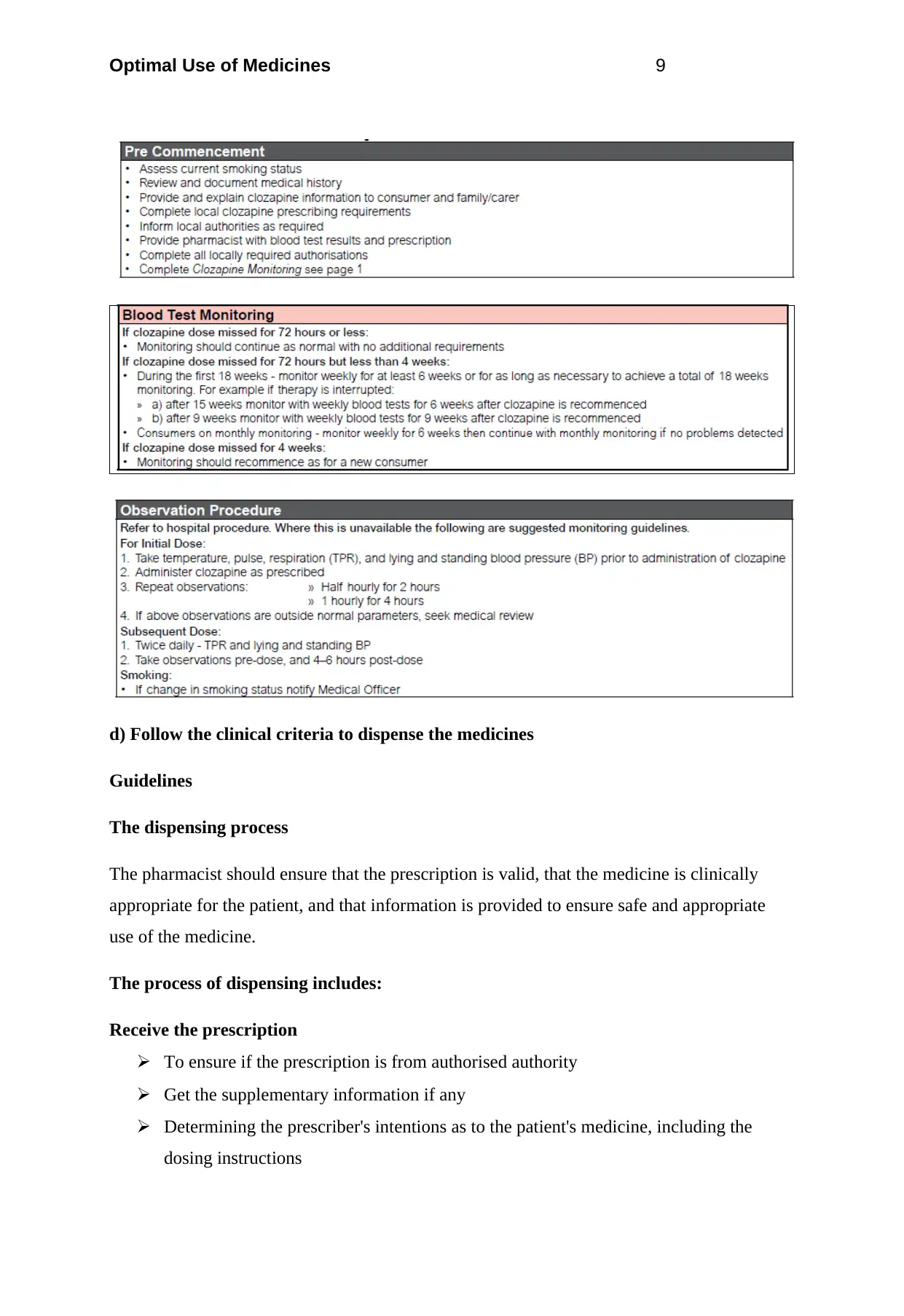
Optimal Use of Medicines 9
d) Follow the clinical criteria to dispense the medicines
Guidelines
The dispensing process
The pharmacist should ensure that the prescription is valid, that the medicine is clinically
appropriate for the patient, and that information is provided to ensure safe and appropriate
use of the medicine.
The process of dispensing includes:
Receive the prescription
To ensure if the prescription is from authorised authority
Get the supplementary information if any
Determining the prescriber's intentions as to the patient's medicine, including the
dosing instructions
d) Follow the clinical criteria to dispense the medicines
Guidelines
The dispensing process
The pharmacist should ensure that the prescription is valid, that the medicine is clinically
appropriate for the patient, and that information is provided to ensure safe and appropriate
use of the medicine.
The process of dispensing includes:
Receive the prescription
To ensure if the prescription is from authorised authority
Get the supplementary information if any
Determining the prescriber's intentions as to the patient's medicine, including the
dosing instructions
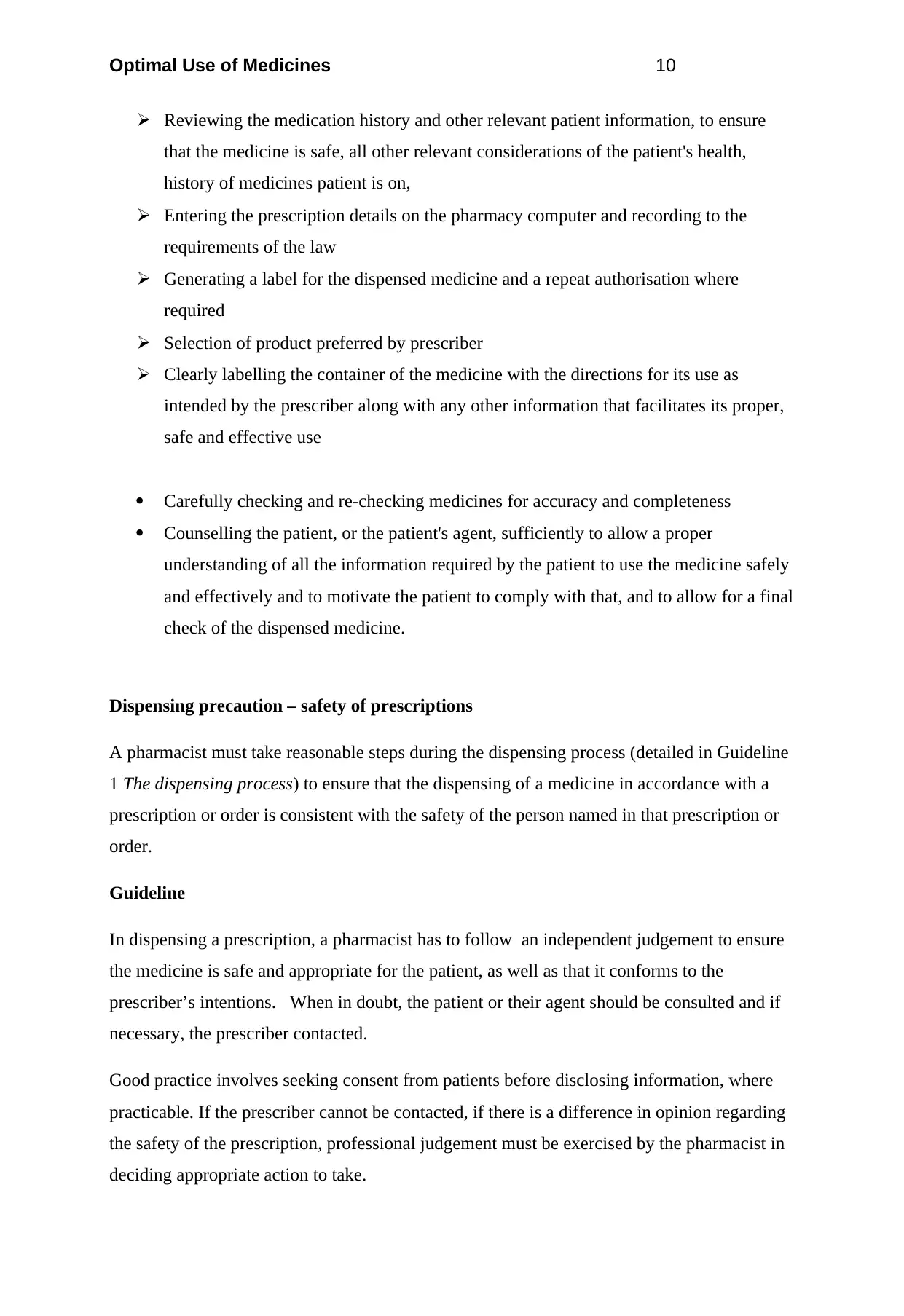
Optimal Use of Medicines 10
Reviewing the medication history and other relevant patient information, to ensure
that the medicine is safe, all other relevant considerations of the patient's health,
history of medicines patient is on,
Entering the prescription details on the pharmacy computer and recording to the
requirements of the law
Generating a label for the dispensed medicine and a repeat authorisation where
required
Selection of product preferred by prescriber
Clearly labelling the container of the medicine with the directions for its use as
intended by the prescriber along with any other information that facilitates its proper,
safe and effective use
Carefully checking and re-checking medicines for accuracy and completeness
Counselling the patient, or the patient's agent, sufficiently to allow a proper
understanding of all the information required by the patient to use the medicine safely
and effectively and to motivate the patient to comply with that, and to allow for a final
check of the dispensed medicine.
Dispensing precaution – safety of prescriptions
A pharmacist must take reasonable steps during the dispensing process (detailed in Guideline
1 The dispensing process) to ensure that the dispensing of a medicine in accordance with a
prescription or order is consistent with the safety of the person named in that prescription or
order.
Guideline
In dispensing a prescription, a pharmacist has to follow an independent judgement to ensure
the medicine is safe and appropriate for the patient, as well as that it conforms to the
prescriber’s intentions. When in doubt, the patient or their agent should be consulted and if
necessary, the prescriber contacted.
Good practice involves seeking consent from patients before disclosing information, where
practicable. If the prescriber cannot be contacted, if there is a difference in opinion regarding
the safety of the prescription, professional judgement must be exercised by the pharmacist in
deciding appropriate action to take.
Reviewing the medication history and other relevant patient information, to ensure
that the medicine is safe, all other relevant considerations of the patient's health,
history of medicines patient is on,
Entering the prescription details on the pharmacy computer and recording to the
requirements of the law
Generating a label for the dispensed medicine and a repeat authorisation where
required
Selection of product preferred by prescriber
Clearly labelling the container of the medicine with the directions for its use as
intended by the prescriber along with any other information that facilitates its proper,
safe and effective use
Carefully checking and re-checking medicines for accuracy and completeness
Counselling the patient, or the patient's agent, sufficiently to allow a proper
understanding of all the information required by the patient to use the medicine safely
and effectively and to motivate the patient to comply with that, and to allow for a final
check of the dispensed medicine.
Dispensing precaution – safety of prescriptions
A pharmacist must take reasonable steps during the dispensing process (detailed in Guideline
1 The dispensing process) to ensure that the dispensing of a medicine in accordance with a
prescription or order is consistent with the safety of the person named in that prescription or
order.
Guideline
In dispensing a prescription, a pharmacist has to follow an independent judgement to ensure
the medicine is safe and appropriate for the patient, as well as that it conforms to the
prescriber’s intentions. When in doubt, the patient or their agent should be consulted and if
necessary, the prescriber contacted.
Good practice involves seeking consent from patients before disclosing information, where
practicable. If the prescriber cannot be contacted, if there is a difference in opinion regarding
the safety of the prescription, professional judgement must be exercised by the pharmacist in
deciding appropriate action to take.
Secure Best Marks with AI Grader
Need help grading? Try our AI Grader for instant feedback on your assignments.
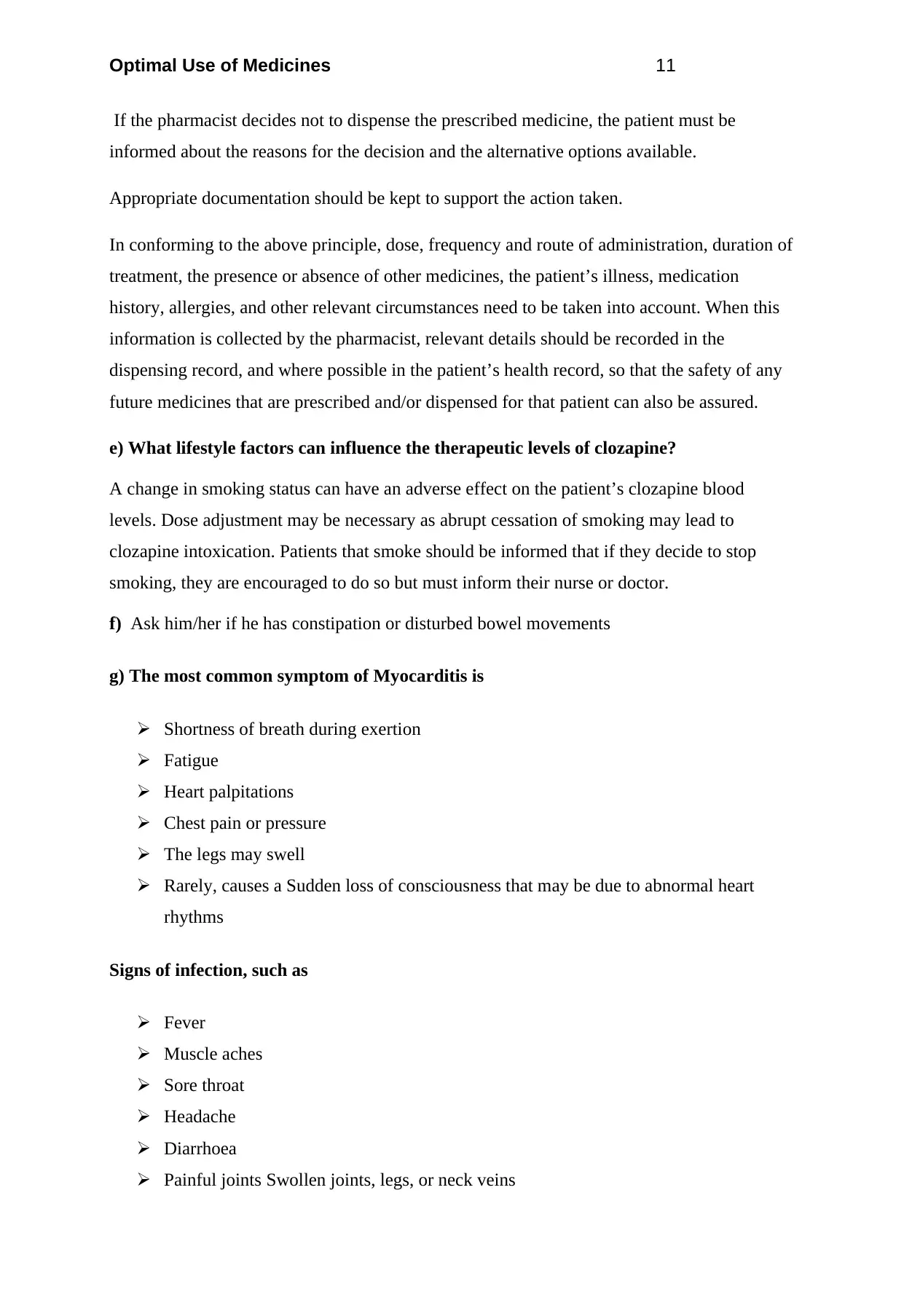
Optimal Use of Medicines 11
If the pharmacist decides not to dispense the prescribed medicine, the patient must be
informed about the reasons for the decision and the alternative options available.
Appropriate documentation should be kept to support the action taken.
In conforming to the above principle, dose, frequency and route of administration, duration of
treatment, the presence or absence of other medicines, the patient’s illness, medication
history, allergies, and other relevant circumstances need to be taken into account. When this
information is collected by the pharmacist, relevant details should be recorded in the
dispensing record, and where possible in the patient’s health record, so that the safety of any
future medicines that are prescribed and/or dispensed for that patient can also be assured.
e) What lifestyle factors can influence the therapeutic levels of clozapine?
A change in smoking status can have an adverse effect on the patient’s clozapine blood
levels. Dose adjustment may be necessary as abrupt cessation of smoking may lead to
clozapine intoxication. Patients that smoke should be informed that if they decide to stop
smoking, they are encouraged to do so but must inform their nurse or doctor.
f) Ask him/her if he has constipation or disturbed bowel movements
g) The most common symptom of Myocarditis is
Shortness of breath during exertion
Fatigue
Heart palpitations
Chest pain or pressure
The legs may swell
Rarely, causes a Sudden loss of consciousness that may be due to abnormal heart
rhythms
Signs of infection, such as
Fever
Muscle aches
Sore throat
Headache
Diarrhoea
Painful joints Swollen joints, legs, or neck veins
If the pharmacist decides not to dispense the prescribed medicine, the patient must be
informed about the reasons for the decision and the alternative options available.
Appropriate documentation should be kept to support the action taken.
In conforming to the above principle, dose, frequency and route of administration, duration of
treatment, the presence or absence of other medicines, the patient’s illness, medication
history, allergies, and other relevant circumstances need to be taken into account. When this
information is collected by the pharmacist, relevant details should be recorded in the
dispensing record, and where possible in the patient’s health record, so that the safety of any
future medicines that are prescribed and/or dispensed for that patient can also be assured.
e) What lifestyle factors can influence the therapeutic levels of clozapine?
A change in smoking status can have an adverse effect on the patient’s clozapine blood
levels. Dose adjustment may be necessary as abrupt cessation of smoking may lead to
clozapine intoxication. Patients that smoke should be informed that if they decide to stop
smoking, they are encouraged to do so but must inform their nurse or doctor.
f) Ask him/her if he has constipation or disturbed bowel movements
g) The most common symptom of Myocarditis is
Shortness of breath during exertion
Fatigue
Heart palpitations
Chest pain or pressure
The legs may swell
Rarely, causes a Sudden loss of consciousness that may be due to abnormal heart
rhythms
Signs of infection, such as
Fever
Muscle aches
Sore throat
Headache
Diarrhoea
Painful joints Swollen joints, legs, or neck veins
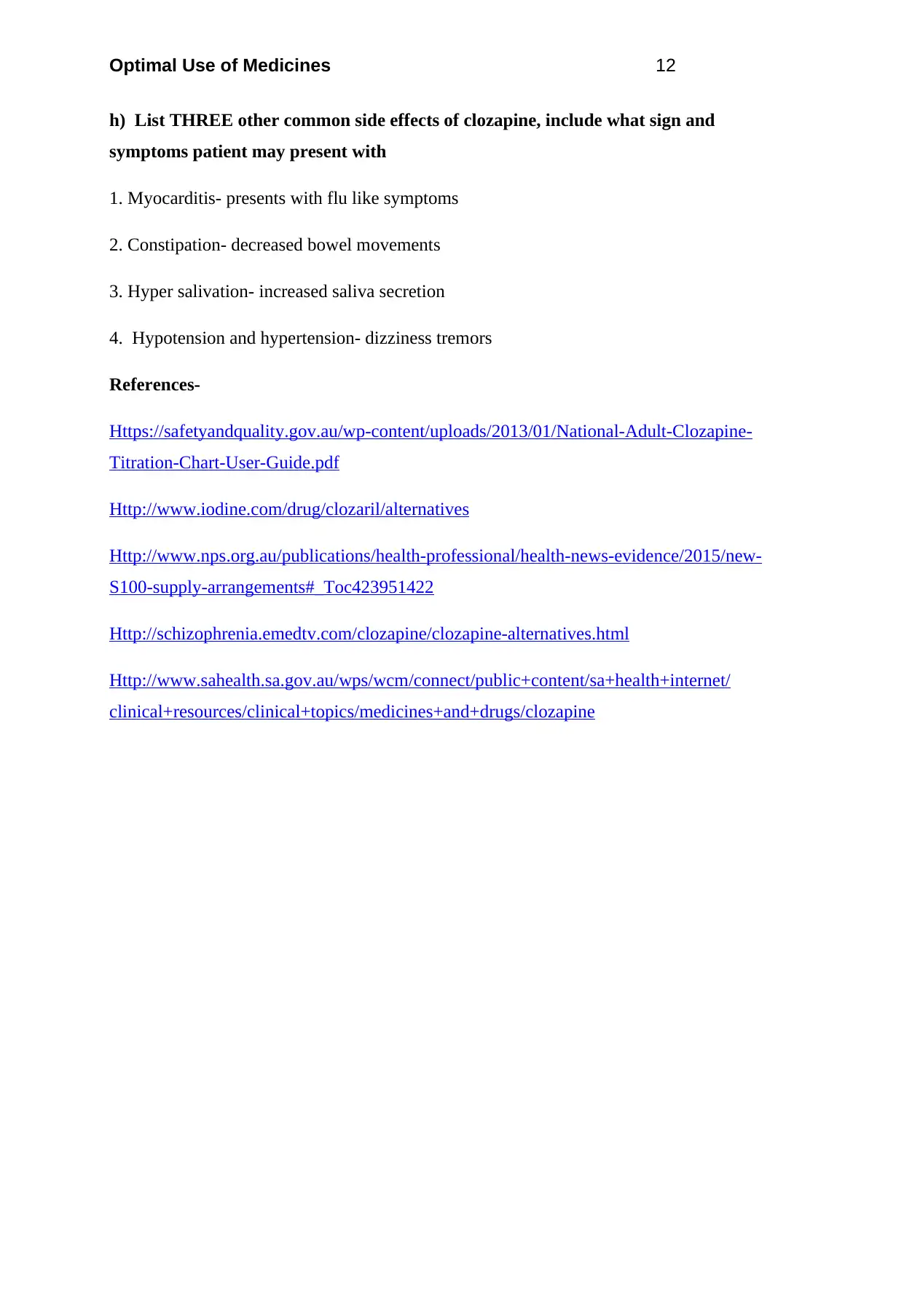
Optimal Use of Medicines 12
h) List THREE other common side effects of clozapine, include what sign and
symptoms patient may present with
1. Myocarditis- presents with flu like symptoms
2. Constipation- decreased bowel movements
3. Hyper salivation- increased saliva secretion
4. Hypotension and hypertension- dizziness tremors
References-
Https://safetyandquality.gov.au/wp-content/uploads/2013/01/National-Adult-Clozapine-
Titration-Chart-User-Guide.pdf
Http://www.iodine.com/drug/clozaril/alternatives
Http://www.nps.org.au/publications/health-professional/health-news-evidence/2015/new-
S100-supply-arrangements#_Toc423951422
Http://schizophrenia.emedtv.com/clozapine/clozapine-alternatives.html
Http://www.sahealth.sa.gov.au/wps/wcm/connect/public+content/sa+health+internet/
clinical+resources/clinical+topics/medicines+and+drugs/clozapine
h) List THREE other common side effects of clozapine, include what sign and
symptoms patient may present with
1. Myocarditis- presents with flu like symptoms
2. Constipation- decreased bowel movements
3. Hyper salivation- increased saliva secretion
4. Hypotension and hypertension- dizziness tremors
References-
Https://safetyandquality.gov.au/wp-content/uploads/2013/01/National-Adult-Clozapine-
Titration-Chart-User-Guide.pdf
Http://www.iodine.com/drug/clozaril/alternatives
Http://www.nps.org.au/publications/health-professional/health-news-evidence/2015/new-
S100-supply-arrangements#_Toc423951422
Http://schizophrenia.emedtv.com/clozapine/clozapine-alternatives.html
Http://www.sahealth.sa.gov.au/wps/wcm/connect/public+content/sa+health+internet/
clinical+resources/clinical+topics/medicines+and+drugs/clozapine
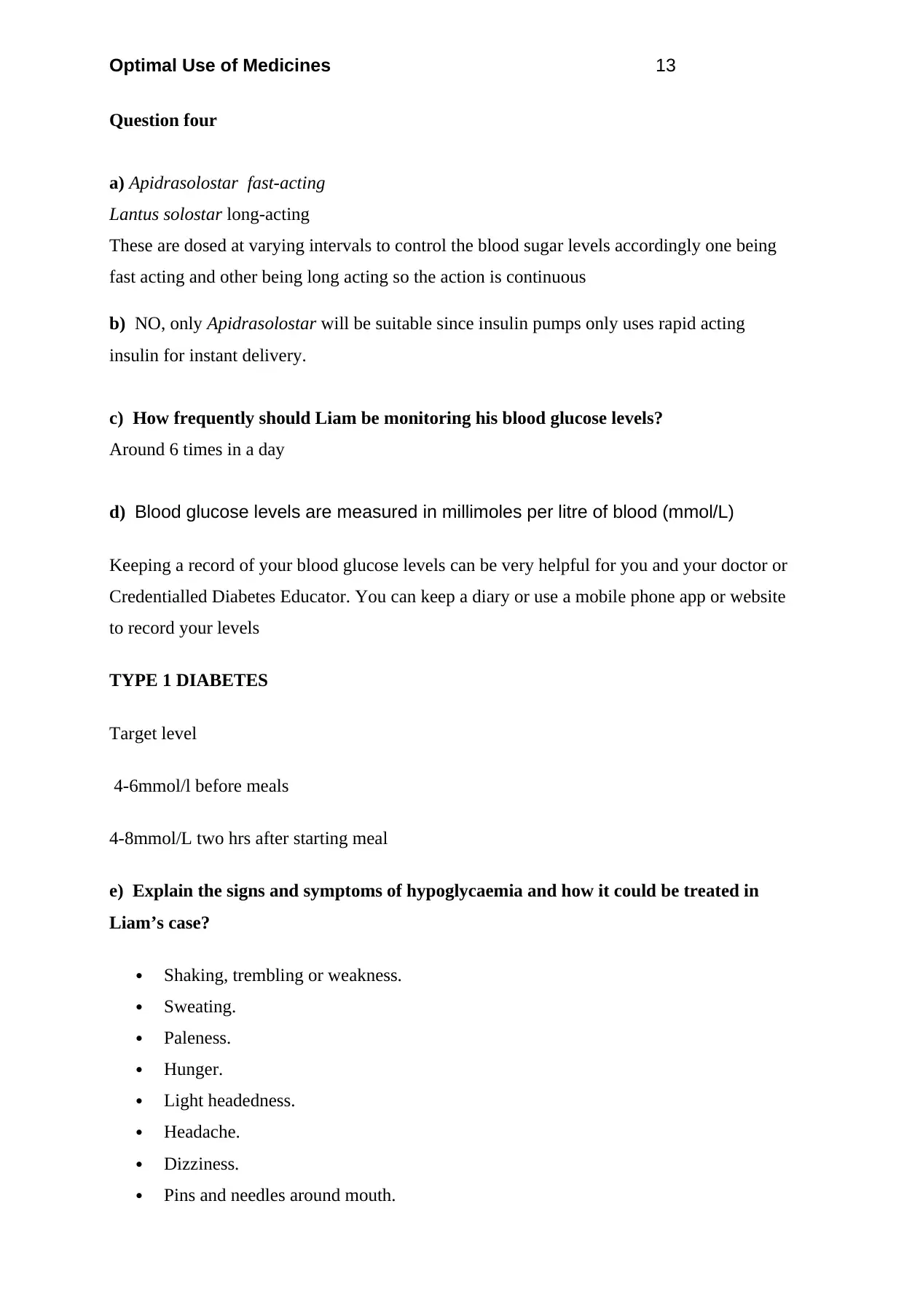
Optimal Use of Medicines 13
Question four
a) Apidrasolostar fast-acting
Lantus solostar long-acting
These are dosed at varying intervals to control the blood sugar levels accordingly one being
fast acting and other being long acting so the action is continuous
b) NO, only Apidrasolostar will be suitable since insulin pumps only uses rapid acting
insulin for instant delivery.
c) How frequently should Liam be monitoring his blood glucose levels?
Around 6 times in a day
d) Blood glucose levels are measured in millimoles per litre of blood (mmol/L)
Keeping a record of your blood glucose levels can be very helpful for you and your doctor or
Credentialled Diabetes Educator. You can keep a diary or use a mobile phone app or website
to record your levels
TYPE 1 DIABETES
Target level
4-6mmol/l before meals
4-8mmol/L two hrs after starting meal
e) Explain the signs and symptoms of hypoglycaemia and how it could be treated in
Liam’s case?
Shaking, trembling or weakness.
Sweating.
Paleness.
Hunger.
Light headedness.
Headache.
Dizziness.
Pins and needles around mouth.
Question four
a) Apidrasolostar fast-acting
Lantus solostar long-acting
These are dosed at varying intervals to control the blood sugar levels accordingly one being
fast acting and other being long acting so the action is continuous
b) NO, only Apidrasolostar will be suitable since insulin pumps only uses rapid acting
insulin for instant delivery.
c) How frequently should Liam be monitoring his blood glucose levels?
Around 6 times in a day
d) Blood glucose levels are measured in millimoles per litre of blood (mmol/L)
Keeping a record of your blood glucose levels can be very helpful for you and your doctor or
Credentialled Diabetes Educator. You can keep a diary or use a mobile phone app or website
to record your levels
TYPE 1 DIABETES
Target level
4-6mmol/l before meals
4-8mmol/L two hrs after starting meal
e) Explain the signs and symptoms of hypoglycaemia and how it could be treated in
Liam’s case?
Shaking, trembling or weakness.
Sweating.
Paleness.
Hunger.
Light headedness.
Headache.
Dizziness.
Pins and needles around mouth.
Paraphrase This Document
Need a fresh take? Get an instant paraphrase of this document with our AI Paraphraser
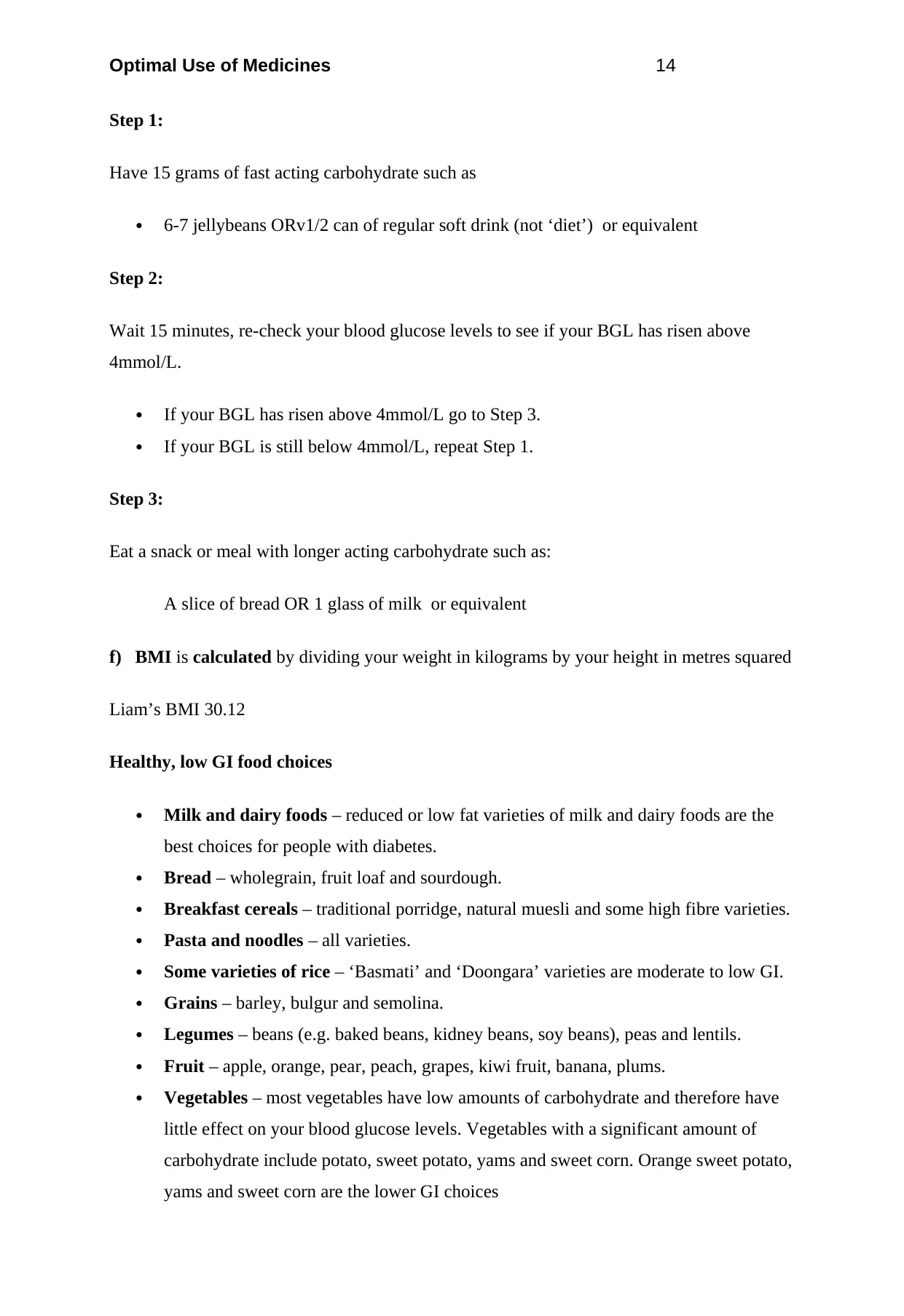
Optimal Use of Medicines 14
Step 1:
Have 15 grams of fast acting carbohydrate such as
6-7 jellybeans ORv1/2 can of regular soft drink (not ‘diet’) or equivalent
Step 2:
Wait 15 minutes, re-check your blood glucose levels to see if your BGL has risen above
4mmol/L.
If your BGL has risen above 4mmol/L go to Step 3.
If your BGL is still below 4mmol/L, repeat Step 1.
Step 3:
Eat a snack or meal with longer acting carbohydrate such as:
A slice of bread OR 1 glass of milk or equivalent
f) BMI is calculated by dividing your weight in kilograms by your height in metres squared
Liam’s BMI 30.12
Healthy, low GI food choices
Milk and dairy foods – reduced or low fat varieties of milk and dairy foods are the
best choices for people with diabetes.
Bread – wholegrain, fruit loaf and sourdough.
Breakfast cereals – traditional porridge, natural muesli and some high fibre varieties.
Pasta and noodles – all varieties.
Some varieties of rice – ‘Basmati’ and ‘Doongara’ varieties are moderate to low GI.
Grains – barley, bulgur and semolina.
Legumes – beans (e.g. baked beans, kidney beans, soy beans), peas and lentils.
Fruit – apple, orange, pear, peach, grapes, kiwi fruit, banana, plums.
Vegetables – most vegetables have low amounts of carbohydrate and therefore have
little effect on your blood glucose levels. Vegetables with a significant amount of
carbohydrate include potato, sweet potato, yams and sweet corn. Orange sweet potato,
yams and sweet corn are the lower GI choices
Step 1:
Have 15 grams of fast acting carbohydrate such as
6-7 jellybeans ORv1/2 can of regular soft drink (not ‘diet’) or equivalent
Step 2:
Wait 15 minutes, re-check your blood glucose levels to see if your BGL has risen above
4mmol/L.
If your BGL has risen above 4mmol/L go to Step 3.
If your BGL is still below 4mmol/L, repeat Step 1.
Step 3:
Eat a snack or meal with longer acting carbohydrate such as:
A slice of bread OR 1 glass of milk or equivalent
f) BMI is calculated by dividing your weight in kilograms by your height in metres squared
Liam’s BMI 30.12
Healthy, low GI food choices
Milk and dairy foods – reduced or low fat varieties of milk and dairy foods are the
best choices for people with diabetes.
Bread – wholegrain, fruit loaf and sourdough.
Breakfast cereals – traditional porridge, natural muesli and some high fibre varieties.
Pasta and noodles – all varieties.
Some varieties of rice – ‘Basmati’ and ‘Doongara’ varieties are moderate to low GI.
Grains – barley, bulgur and semolina.
Legumes – beans (e.g. baked beans, kidney beans, soy beans), peas and lentils.
Fruit – apple, orange, pear, peach, grapes, kiwi fruit, banana, plums.
Vegetables – most vegetables have low amounts of carbohydrate and therefore have
little effect on your blood glucose levels. Vegetables with a significant amount of
carbohydrate include potato, sweet potato, yams and sweet corn. Orange sweet potato,
yams and sweet corn are the lower GI choices
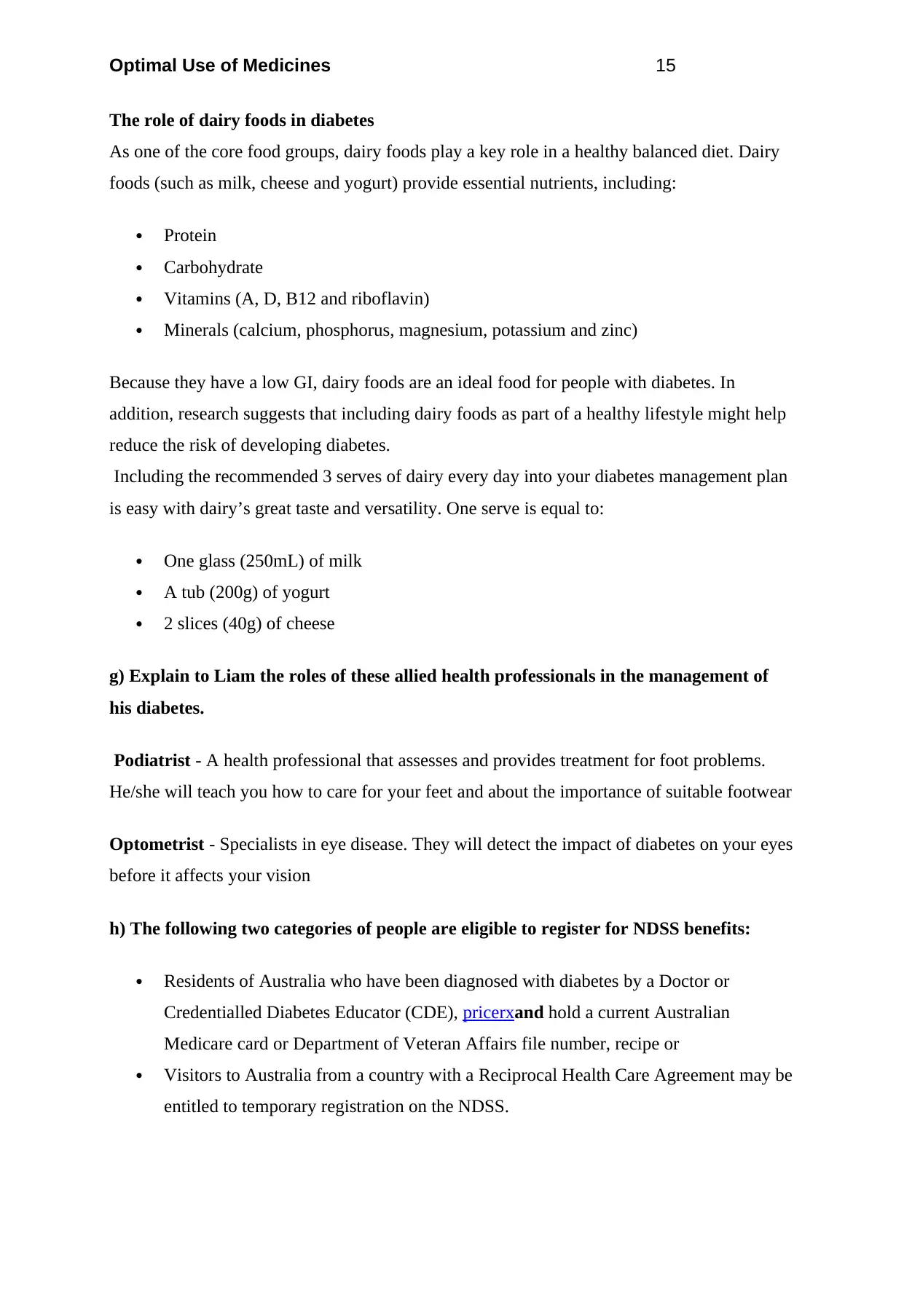
Optimal Use of Medicines 15
The role of dairy foods in diabetes
As one of the core food groups, dairy foods play a key role in a healthy balanced diet. Dairy
foods (such as milk, cheese and yogurt) provide essential nutrients, including:
Protein
Carbohydrate
Vitamins (A, D, B12 and riboflavin)
Minerals (calcium, phosphorus, magnesium, potassium and zinc)
Because they have a low GI, dairy foods are an ideal food for people with diabetes. In
addition, research suggests that including dairy foods as part of a healthy lifestyle might help
reduce the risk of developing diabetes.
Including the recommended 3 serves of dairy every day into your diabetes management plan
is easy with dairy’s great taste and versatility. One serve is equal to:
One glass (250mL) of milk
A tub (200g) of yogurt
2 slices (40g) of cheese
g) Explain to Liam the roles of these allied health professionals in the management of
his diabetes.
Podiatrist - A health professional that assesses and provides treatment for foot problems.
He/she will teach you how to care for your feet and about the importance of suitable footwear
Optometrist - Specialists in eye disease. They will detect the impact of diabetes on your eyes
before it affects your vision
h) The following two categories of people are eligible to register for NDSS benefits:
Residents of Australia who have been diagnosed with diabetes by a Doctor or
Credentialled Diabetes Educator (CDE), pricerxand hold a current Australian
Medicare card or Department of Veteran Affairs file number, recipe or
Visitors to Australia from a country with a Reciprocal Health Care Agreement may be
entitled to temporary registration on the NDSS.
The role of dairy foods in diabetes
As one of the core food groups, dairy foods play a key role in a healthy balanced diet. Dairy
foods (such as milk, cheese and yogurt) provide essential nutrients, including:
Protein
Carbohydrate
Vitamins (A, D, B12 and riboflavin)
Minerals (calcium, phosphorus, magnesium, potassium and zinc)
Because they have a low GI, dairy foods are an ideal food for people with diabetes. In
addition, research suggests that including dairy foods as part of a healthy lifestyle might help
reduce the risk of developing diabetes.
Including the recommended 3 serves of dairy every day into your diabetes management plan
is easy with dairy’s great taste and versatility. One serve is equal to:
One glass (250mL) of milk
A tub (200g) of yogurt
2 slices (40g) of cheese
g) Explain to Liam the roles of these allied health professionals in the management of
his diabetes.
Podiatrist - A health professional that assesses and provides treatment for foot problems.
He/she will teach you how to care for your feet and about the importance of suitable footwear
Optometrist - Specialists in eye disease. They will detect the impact of diabetes on your eyes
before it affects your vision
h) The following two categories of people are eligible to register for NDSS benefits:
Residents of Australia who have been diagnosed with diabetes by a Doctor or
Credentialled Diabetes Educator (CDE), pricerxand hold a current Australian
Medicare card or Department of Veteran Affairs file number, recipe or
Visitors to Australia from a country with a Reciprocal Health Care Agreement may be
entitled to temporary registration on the NDSS.
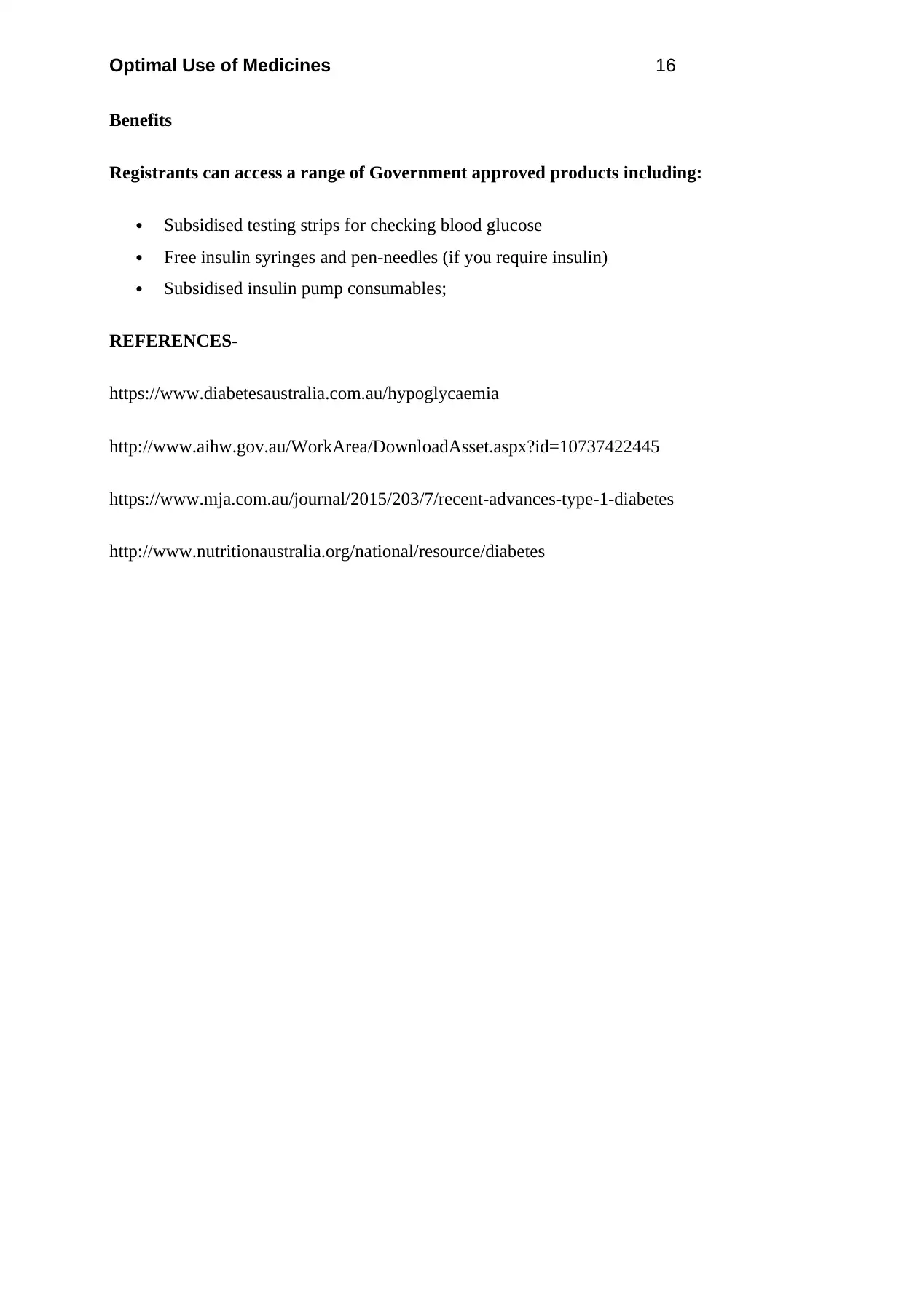
Optimal Use of Medicines 16
Benefits
Registrants can access a range of Government approved products including:
Subsidised testing strips for checking blood glucose
Free insulin syringes and pen-needles (if you require insulin)
Subsidised insulin pump consumables;
REFERENCES-
https://www.diabetesaustralia.com.au/hypoglycaemia
http://www.aihw.gov.au/WorkArea/DownloadAsset.aspx?id=10737422445
https://www.mja.com.au/journal/2015/203/7/recent-advances-type-1-diabetes
http://www.nutritionaustralia.org/national/resource/diabetes
Benefits
Registrants can access a range of Government approved products including:
Subsidised testing strips for checking blood glucose
Free insulin syringes and pen-needles (if you require insulin)
Subsidised insulin pump consumables;
REFERENCES-
https://www.diabetesaustralia.com.au/hypoglycaemia
http://www.aihw.gov.au/WorkArea/DownloadAsset.aspx?id=10737422445
https://www.mja.com.au/journal/2015/203/7/recent-advances-type-1-diabetes
http://www.nutritionaustralia.org/national/resource/diabetes
Secure Best Marks with AI Grader
Need help grading? Try our AI Grader for instant feedback on your assignments.
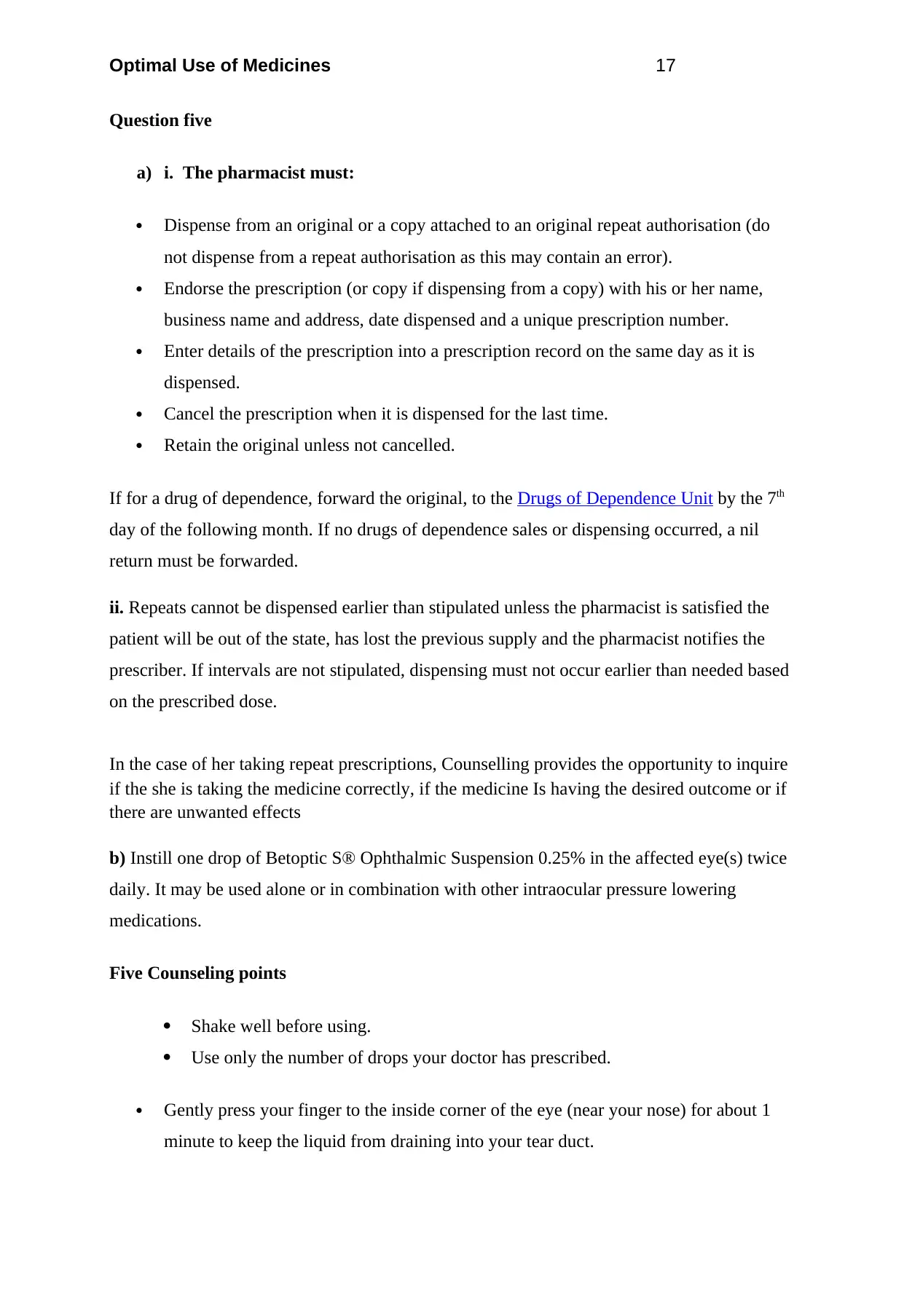
Optimal Use of Medicines 17
Question five
a) i. The pharmacist must:
Dispense from an original or a copy attached to an original repeat authorisation (do
not dispense from a repeat authorisation as this may contain an error).
Endorse the prescription (or copy if dispensing from a copy) with his or her name,
business name and address, date dispensed and a unique prescription number.
Enter details of the prescription into a prescription record on the same day as it is
dispensed.
Cancel the prescription when it is dispensed for the last time.
Retain the original unless not cancelled.
If for a drug of dependence, forward the original, to the Drugs of Dependence Unit by the 7th
day of the following month. If no drugs of dependence sales or dispensing occurred, a nil
return must be forwarded.
ii. Repeats cannot be dispensed earlier than stipulated unless the pharmacist is satisfied the
patient will be out of the state, has lost the previous supply and the pharmacist notifies the
prescriber. If intervals are not stipulated, dispensing must not occur earlier than needed based
on the prescribed dose.
In the case of her taking repeat prescriptions, Counselling provides the opportunity to inquire
if the she is taking the medicine correctly, if the medicine Is having the desired outcome or if
there are unwanted effects
b) Instill one drop of Betoptic S® Ophthalmic Suspension 0.25% in the affected eye(s) twice
daily. It may be used alone or in combination with other intraocular pressure lowering
medications.
Five Counseling points
Shake well before using.
Use only the number of drops your doctor has prescribed.
Gently press your finger to the inside corner of the eye (near your nose) for about 1
minute to keep the liquid from draining into your tear duct.
Question five
a) i. The pharmacist must:
Dispense from an original or a copy attached to an original repeat authorisation (do
not dispense from a repeat authorisation as this may contain an error).
Endorse the prescription (or copy if dispensing from a copy) with his or her name,
business name and address, date dispensed and a unique prescription number.
Enter details of the prescription into a prescription record on the same day as it is
dispensed.
Cancel the prescription when it is dispensed for the last time.
Retain the original unless not cancelled.
If for a drug of dependence, forward the original, to the Drugs of Dependence Unit by the 7th
day of the following month. If no drugs of dependence sales or dispensing occurred, a nil
return must be forwarded.
ii. Repeats cannot be dispensed earlier than stipulated unless the pharmacist is satisfied the
patient will be out of the state, has lost the previous supply and the pharmacist notifies the
prescriber. If intervals are not stipulated, dispensing must not occur earlier than needed based
on the prescribed dose.
In the case of her taking repeat prescriptions, Counselling provides the opportunity to inquire
if the she is taking the medicine correctly, if the medicine Is having the desired outcome or if
there are unwanted effects
b) Instill one drop of Betoptic S® Ophthalmic Suspension 0.25% in the affected eye(s) twice
daily. It may be used alone or in combination with other intraocular pressure lowering
medications.
Five Counseling points
Shake well before using.
Use only the number of drops your doctor has prescribed.
Gently press your finger to the inside corner of the eye (near your nose) for about 1
minute to keep the liquid from draining into your tear duct.
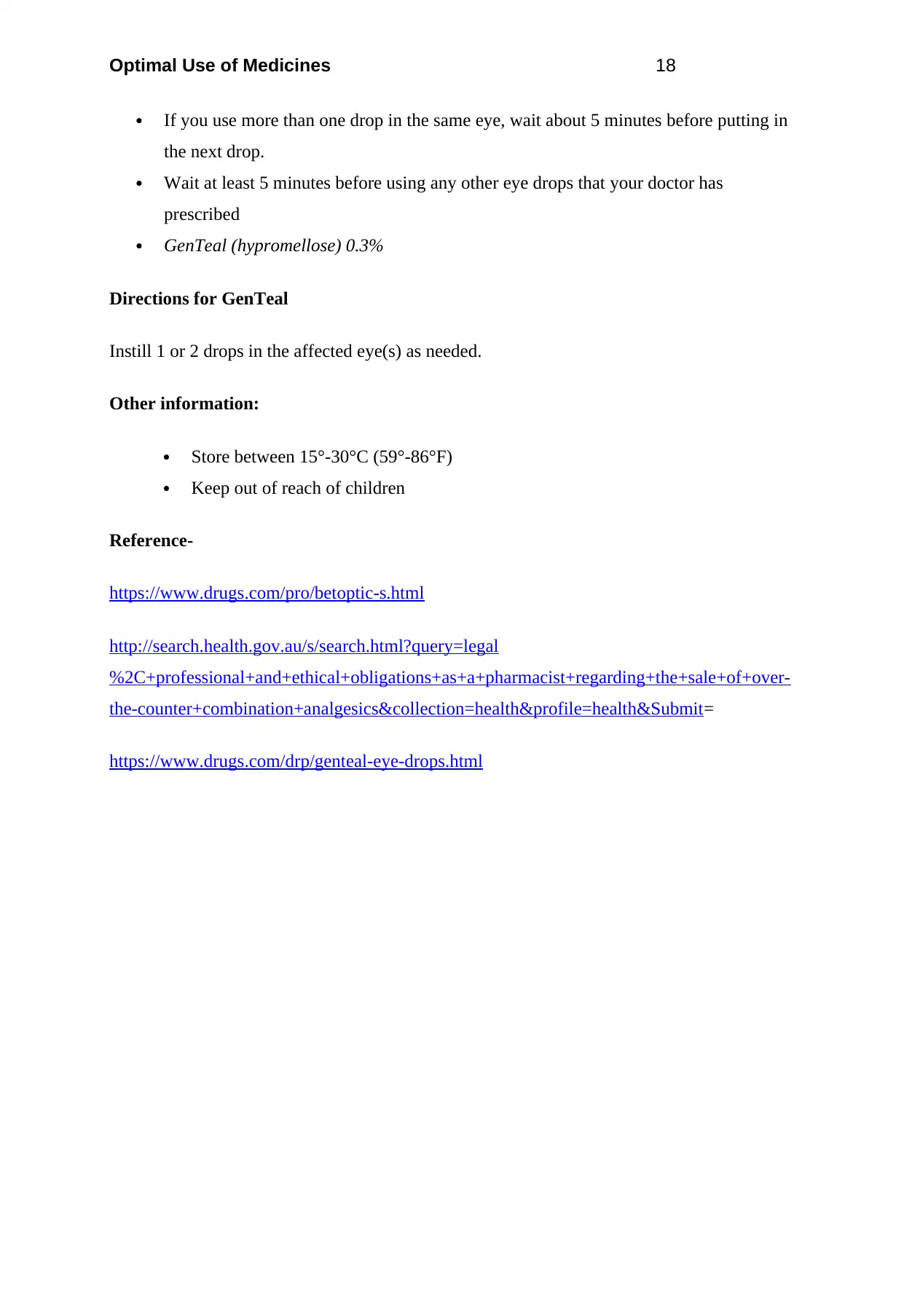
Optimal Use of Medicines 18
If you use more than one drop in the same eye, wait about 5 minutes before putting in
the next drop.
Wait at least 5 minutes before using any other eye drops that your doctor has
prescribed
GenTeal (hypromellose) 0.3%
Directions for GenTeal
Instill 1 or 2 drops in the affected eye(s) as needed.
Other information:
Store between 15°-30°C (59°-86°F)
Keep out of reach of children
Reference-
https://www.drugs.com/pro/betoptic-s.html
http://search.health.gov.au/s/search.html?query=legal
%2C+professional+and+ethical+obligations+as+a+pharmacist+regarding+the+sale+of+over-
the-counter+combination+analgesics&collection=health&profile=health&Submit=
https://www.drugs.com/drp/genteal-eye-drops.html
If you use more than one drop in the same eye, wait about 5 minutes before putting in
the next drop.
Wait at least 5 minutes before using any other eye drops that your doctor has
prescribed
GenTeal (hypromellose) 0.3%
Directions for GenTeal
Instill 1 or 2 drops in the affected eye(s) as needed.
Other information:
Store between 15°-30°C (59°-86°F)
Keep out of reach of children
Reference-
https://www.drugs.com/pro/betoptic-s.html
http://search.health.gov.au/s/search.html?query=legal
%2C+professional+and+ethical+obligations+as+a+pharmacist+regarding+the+sale+of+over-
the-counter+combination+analgesics&collection=health&profile=health&Submit=
https://www.drugs.com/drp/genteal-eye-drops.html
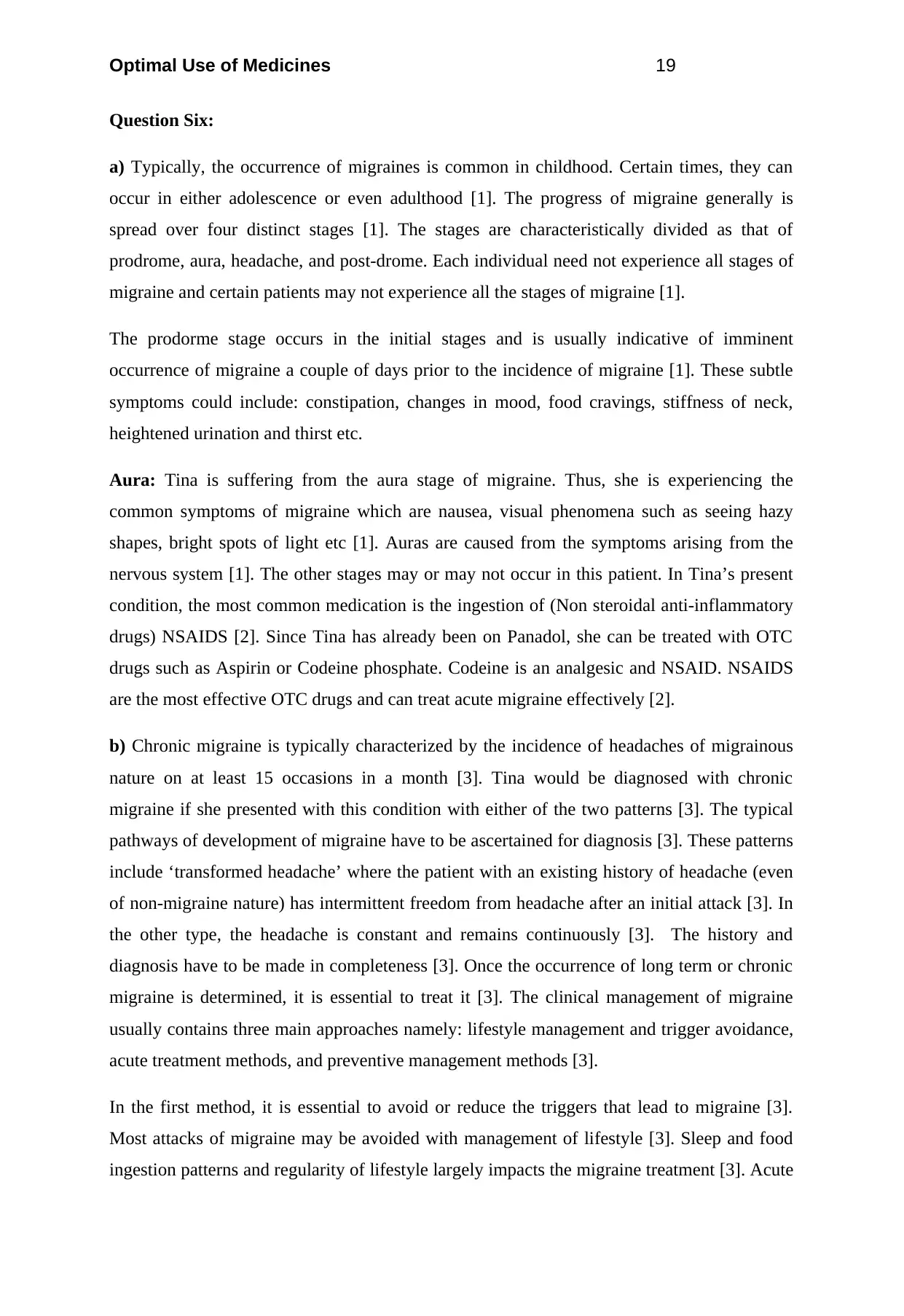
Optimal Use of Medicines 19
Question Six:
a) Typically, the occurrence of migraines is common in childhood. Certain times, they can
occur in either adolescence or even adulthood [1]. The progress of migraine generally is
spread over four distinct stages [1]. The stages are characteristically divided as that of
prodrome, aura, headache, and post-drome. Each individual need not experience all stages of
migraine and certain patients may not experience all the stages of migraine [1].
The prodorme stage occurs in the initial stages and is usually indicative of imminent
occurrence of migraine a couple of days prior to the incidence of migraine [1]. These subtle
symptoms could include: constipation, changes in mood, food cravings, stiffness of neck,
heightened urination and thirst etc.
Aura: Tina is suffering from the aura stage of migraine. Thus, she is experiencing the
common symptoms of migraine which are nausea, visual phenomena such as seeing hazy
shapes, bright spots of light etc [1]. Auras are caused from the symptoms arising from the
nervous system [1]. The other stages may or may not occur in this patient. In Tina’s present
condition, the most common medication is the ingestion of (Non steroidal anti-inflammatory
drugs) NSAIDS [2]. Since Tina has already been on Panadol, she can be treated with OTC
drugs such as Aspirin or Codeine phosphate. Codeine is an analgesic and NSAID. NSAIDS
are the most effective OTC drugs and can treat acute migraine effectively [2].
b) Chronic migraine is typically characterized by the incidence of headaches of migrainous
nature on at least 15 occasions in a month [3]. Tina would be diagnosed with chronic
migraine if she presented with this condition with either of the two patterns [3]. The typical
pathways of development of migraine have to be ascertained for diagnosis [3]. These patterns
include ‘transformed headache’ where the patient with an existing history of headache (even
of non-migraine nature) has intermittent freedom from headache after an initial attack [3]. In
the other type, the headache is constant and remains continuously [3]. The history and
diagnosis have to be made in completeness [3]. Once the occurrence of long term or chronic
migraine is determined, it is essential to treat it [3]. The clinical management of migraine
usually contains three main approaches namely: lifestyle management and trigger avoidance,
acute treatment methods, and preventive management methods [3].
In the first method, it is essential to avoid or reduce the triggers that lead to migraine [3].
Most attacks of migraine may be avoided with management of lifestyle [3]. Sleep and food
ingestion patterns and regularity of lifestyle largely impacts the migraine treatment [3]. Acute
Question Six:
a) Typically, the occurrence of migraines is common in childhood. Certain times, they can
occur in either adolescence or even adulthood [1]. The progress of migraine generally is
spread over four distinct stages [1]. The stages are characteristically divided as that of
prodrome, aura, headache, and post-drome. Each individual need not experience all stages of
migraine and certain patients may not experience all the stages of migraine [1].
The prodorme stage occurs in the initial stages and is usually indicative of imminent
occurrence of migraine a couple of days prior to the incidence of migraine [1]. These subtle
symptoms could include: constipation, changes in mood, food cravings, stiffness of neck,
heightened urination and thirst etc.
Aura: Tina is suffering from the aura stage of migraine. Thus, she is experiencing the
common symptoms of migraine which are nausea, visual phenomena such as seeing hazy
shapes, bright spots of light etc [1]. Auras are caused from the symptoms arising from the
nervous system [1]. The other stages may or may not occur in this patient. In Tina’s present
condition, the most common medication is the ingestion of (Non steroidal anti-inflammatory
drugs) NSAIDS [2]. Since Tina has already been on Panadol, she can be treated with OTC
drugs such as Aspirin or Codeine phosphate. Codeine is an analgesic and NSAID. NSAIDS
are the most effective OTC drugs and can treat acute migraine effectively [2].
b) Chronic migraine is typically characterized by the incidence of headaches of migrainous
nature on at least 15 occasions in a month [3]. Tina would be diagnosed with chronic
migraine if she presented with this condition with either of the two patterns [3]. The typical
pathways of development of migraine have to be ascertained for diagnosis [3]. These patterns
include ‘transformed headache’ where the patient with an existing history of headache (even
of non-migraine nature) has intermittent freedom from headache after an initial attack [3]. In
the other type, the headache is constant and remains continuously [3]. The history and
diagnosis have to be made in completeness [3]. Once the occurrence of long term or chronic
migraine is determined, it is essential to treat it [3]. The clinical management of migraine
usually contains three main approaches namely: lifestyle management and trigger avoidance,
acute treatment methods, and preventive management methods [3].
In the first method, it is essential to avoid or reduce the triggers that lead to migraine [3].
Most attacks of migraine may be avoided with management of lifestyle [3]. Sleep and food
ingestion patterns and regularity of lifestyle largely impacts the migraine treatment [3]. Acute
Paraphrase This Document
Need a fresh take? Get an instant paraphrase of this document with our AI Paraphraser
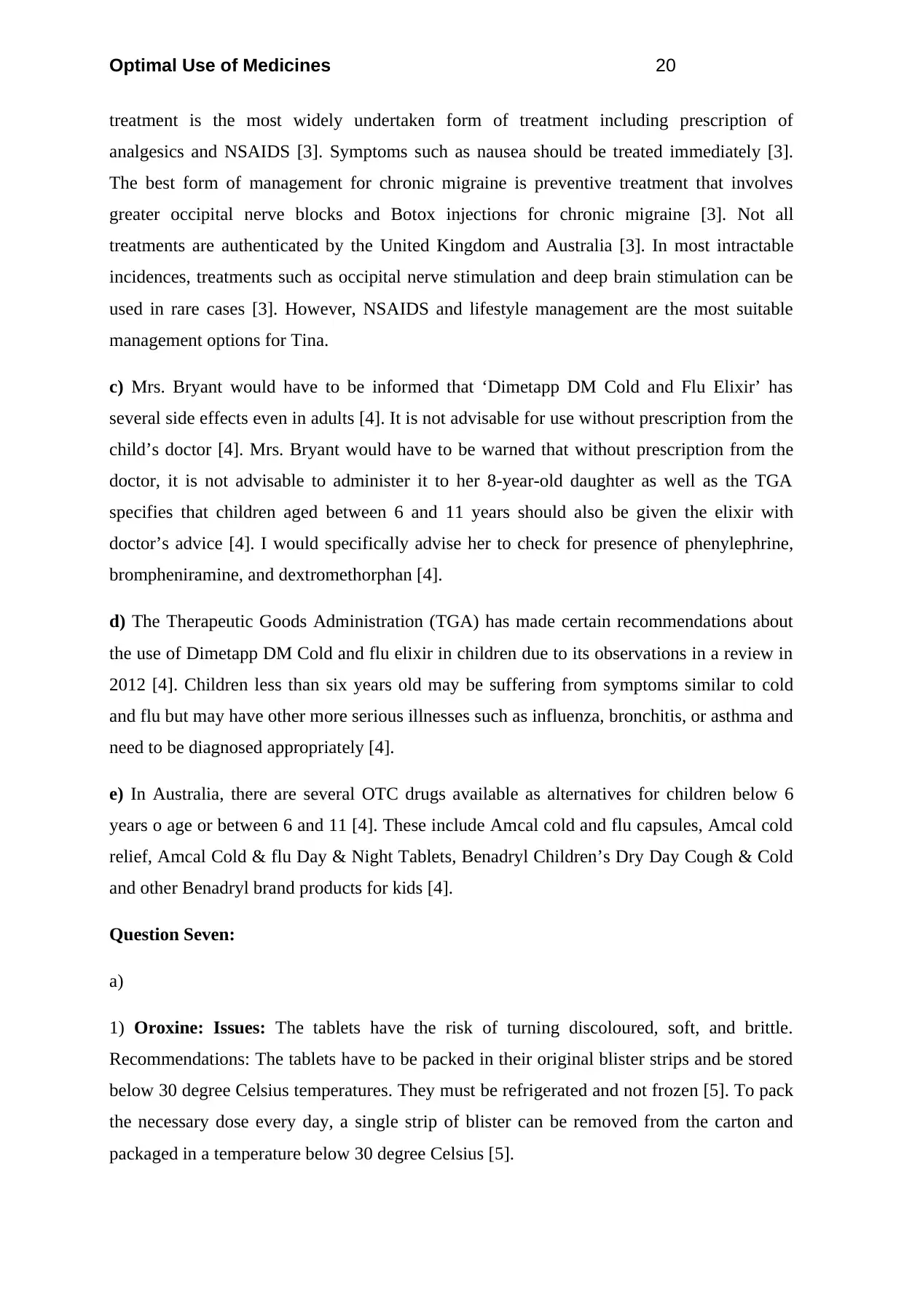
Optimal Use of Medicines 20
treatment is the most widely undertaken form of treatment including prescription of
analgesics and NSAIDS [3]. Symptoms such as nausea should be treated immediately [3].
The best form of management for chronic migraine is preventive treatment that involves
greater occipital nerve blocks and Botox injections for chronic migraine [3]. Not all
treatments are authenticated by the United Kingdom and Australia [3]. In most intractable
incidences, treatments such as occipital nerve stimulation and deep brain stimulation can be
used in rare cases [3]. However, NSAIDS and lifestyle management are the most suitable
management options for Tina.
c) Mrs. Bryant would have to be informed that ‘Dimetapp DM Cold and Flu Elixir’ has
several side effects even in adults [4]. It is not advisable for use without prescription from the
child’s doctor [4]. Mrs. Bryant would have to be warned that without prescription from the
doctor, it is not advisable to administer it to her 8-year-old daughter as well as the TGA
specifies that children aged between 6 and 11 years should also be given the elixir with
doctor’s advice [4]. I would specifically advise her to check for presence of phenylephrine,
brompheniramine, and dextromethorphan [4].
d) The Therapeutic Goods Administration (TGA) has made certain recommendations about
the use of Dimetapp DM Cold and flu elixir in children due to its observations in a review in
2012 [4]. Children less than six years old may be suffering from symptoms similar to cold
and flu but may have other more serious illnesses such as influenza, bronchitis, or asthma and
need to be diagnosed appropriately [4].
e) In Australia, there are several OTC drugs available as alternatives for children below 6
years o age or between 6 and 11 [4]. These include Amcal cold and flu capsules, Amcal cold
relief, Amcal Cold & flu Day & Night Tablets, Benadryl Children’s Dry Day Cough & Cold
and other Benadryl brand products for kids [4].
Question Seven:
a)
1) Oroxine: Issues: The tablets have the risk of turning discoloured, soft, and brittle.
Recommendations: The tablets have to be packed in their original blister strips and be stored
below 30 degree Celsius temperatures. They must be refrigerated and not frozen [5]. To pack
the necessary dose every day, a single strip of blister can be removed from the carton and
packaged in a temperature below 30 degree Celsius [5].
treatment is the most widely undertaken form of treatment including prescription of
analgesics and NSAIDS [3]. Symptoms such as nausea should be treated immediately [3].
The best form of management for chronic migraine is preventive treatment that involves
greater occipital nerve blocks and Botox injections for chronic migraine [3]. Not all
treatments are authenticated by the United Kingdom and Australia [3]. In most intractable
incidences, treatments such as occipital nerve stimulation and deep brain stimulation can be
used in rare cases [3]. However, NSAIDS and lifestyle management are the most suitable
management options for Tina.
c) Mrs. Bryant would have to be informed that ‘Dimetapp DM Cold and Flu Elixir’ has
several side effects even in adults [4]. It is not advisable for use without prescription from the
child’s doctor [4]. Mrs. Bryant would have to be warned that without prescription from the
doctor, it is not advisable to administer it to her 8-year-old daughter as well as the TGA
specifies that children aged between 6 and 11 years should also be given the elixir with
doctor’s advice [4]. I would specifically advise her to check for presence of phenylephrine,
brompheniramine, and dextromethorphan [4].
d) The Therapeutic Goods Administration (TGA) has made certain recommendations about
the use of Dimetapp DM Cold and flu elixir in children due to its observations in a review in
2012 [4]. Children less than six years old may be suffering from symptoms similar to cold
and flu but may have other more serious illnesses such as influenza, bronchitis, or asthma and
need to be diagnosed appropriately [4].
e) In Australia, there are several OTC drugs available as alternatives for children below 6
years o age or between 6 and 11 [4]. These include Amcal cold and flu capsules, Amcal cold
relief, Amcal Cold & flu Day & Night Tablets, Benadryl Children’s Dry Day Cough & Cold
and other Benadryl brand products for kids [4].
Question Seven:
a)
1) Oroxine: Issues: The tablets have the risk of turning discoloured, soft, and brittle.
Recommendations: The tablets have to be packed in their original blister strips and be stored
below 30 degree Celsius temperatures. They must be refrigerated and not frozen [5]. To pack
the necessary dose every day, a single strip of blister can be removed from the carton and
packaged in a temperature below 30 degree Celsius [5].
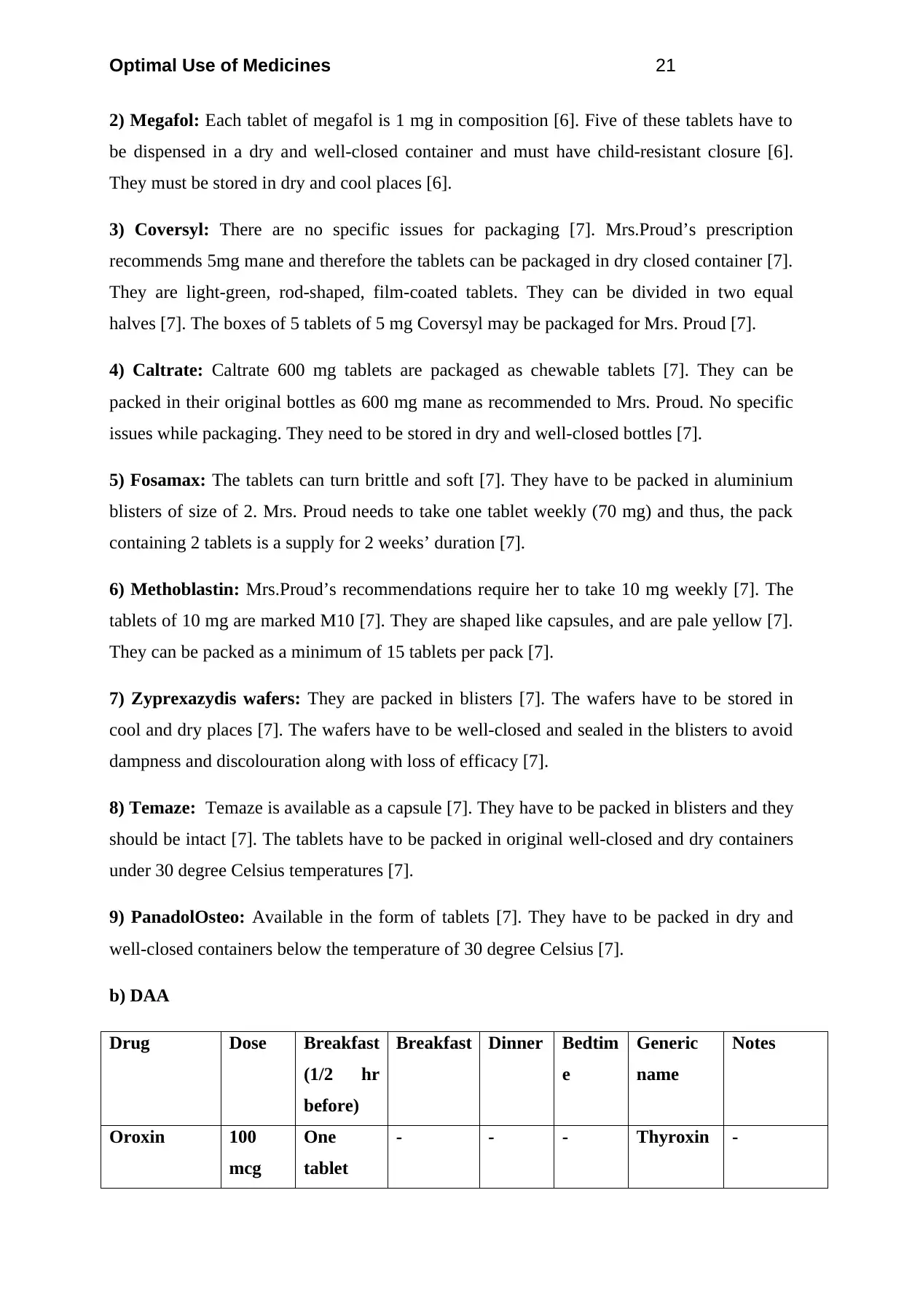
Optimal Use of Medicines 21
2) Megafol: Each tablet of megafol is 1 mg in composition [6]. Five of these tablets have to
be dispensed in a dry and well-closed container and must have child-resistant closure [6].
They must be stored in dry and cool places [6].
3) Coversyl: There are no specific issues for packaging [7]. Mrs.Proud’s prescription
recommends 5mg mane and therefore the tablets can be packaged in dry closed container [7].
They are light-green, rod-shaped, film-coated tablets. They can be divided in two equal
halves [7]. The boxes of 5 tablets of 5 mg Coversyl may be packaged for Mrs. Proud [7].
4) Caltrate: Caltrate 600 mg tablets are packaged as chewable tablets [7]. They can be
packed in their original bottles as 600 mg mane as recommended to Mrs. Proud. No specific
issues while packaging. They need to be stored in dry and well-closed bottles [7].
5) Fosamax: The tablets can turn brittle and soft [7]. They have to be packed in aluminium
blisters of size of 2. Mrs. Proud needs to take one tablet weekly (70 mg) and thus, the pack
containing 2 tablets is a supply for 2 weeks’ duration [7].
6) Methoblastin: Mrs.Proud’s recommendations require her to take 10 mg weekly [7]. The
tablets of 10 mg are marked M10 [7]. They are shaped like capsules, and are pale yellow [7].
They can be packed as a minimum of 15 tablets per pack [7].
7) Zyprexazydis wafers: They are packed in blisters [7]. The wafers have to be stored in
cool and dry places [7]. The wafers have to be well-closed and sealed in the blisters to avoid
dampness and discolouration along with loss of efficacy [7].
8) Temaze: Temaze is available as a capsule [7]. They have to be packed in blisters and they
should be intact [7]. The tablets have to be packed in original well-closed and dry containers
under 30 degree Celsius temperatures [7].
9) PanadolOsteo: Available in the form of tablets [7]. They have to be packed in dry and
well-closed containers below the temperature of 30 degree Celsius [7].
b) DAA
Drug Dose Breakfast
(1/2 hr
before)
Breakfast Dinner Bedtim
e
Generic
name
Notes
Oroxin 100
mcg
One
tablet
- - - Thyroxin -
2) Megafol: Each tablet of megafol is 1 mg in composition [6]. Five of these tablets have to
be dispensed in a dry and well-closed container and must have child-resistant closure [6].
They must be stored in dry and cool places [6].
3) Coversyl: There are no specific issues for packaging [7]. Mrs.Proud’s prescription
recommends 5mg mane and therefore the tablets can be packaged in dry closed container [7].
They are light-green, rod-shaped, film-coated tablets. They can be divided in two equal
halves [7]. The boxes of 5 tablets of 5 mg Coversyl may be packaged for Mrs. Proud [7].
4) Caltrate: Caltrate 600 mg tablets are packaged as chewable tablets [7]. They can be
packed in their original bottles as 600 mg mane as recommended to Mrs. Proud. No specific
issues while packaging. They need to be stored in dry and well-closed bottles [7].
5) Fosamax: The tablets can turn brittle and soft [7]. They have to be packed in aluminium
blisters of size of 2. Mrs. Proud needs to take one tablet weekly (70 mg) and thus, the pack
containing 2 tablets is a supply for 2 weeks’ duration [7].
6) Methoblastin: Mrs.Proud’s recommendations require her to take 10 mg weekly [7]. The
tablets of 10 mg are marked M10 [7]. They are shaped like capsules, and are pale yellow [7].
They can be packed as a minimum of 15 tablets per pack [7].
7) Zyprexazydis wafers: They are packed in blisters [7]. The wafers have to be stored in
cool and dry places [7]. The wafers have to be well-closed and sealed in the blisters to avoid
dampness and discolouration along with loss of efficacy [7].
8) Temaze: Temaze is available as a capsule [7]. They have to be packed in blisters and they
should be intact [7]. The tablets have to be packed in original well-closed and dry containers
under 30 degree Celsius temperatures [7].
9) PanadolOsteo: Available in the form of tablets [7]. They have to be packed in dry and
well-closed containers below the temperature of 30 degree Celsius [7].
b) DAA
Drug Dose Breakfast
(1/2 hr
before)
Breakfast Dinner Bedtim
e
Generic
name
Notes
Oroxin 100
mcg
One
tablet
- - - Thyroxin -
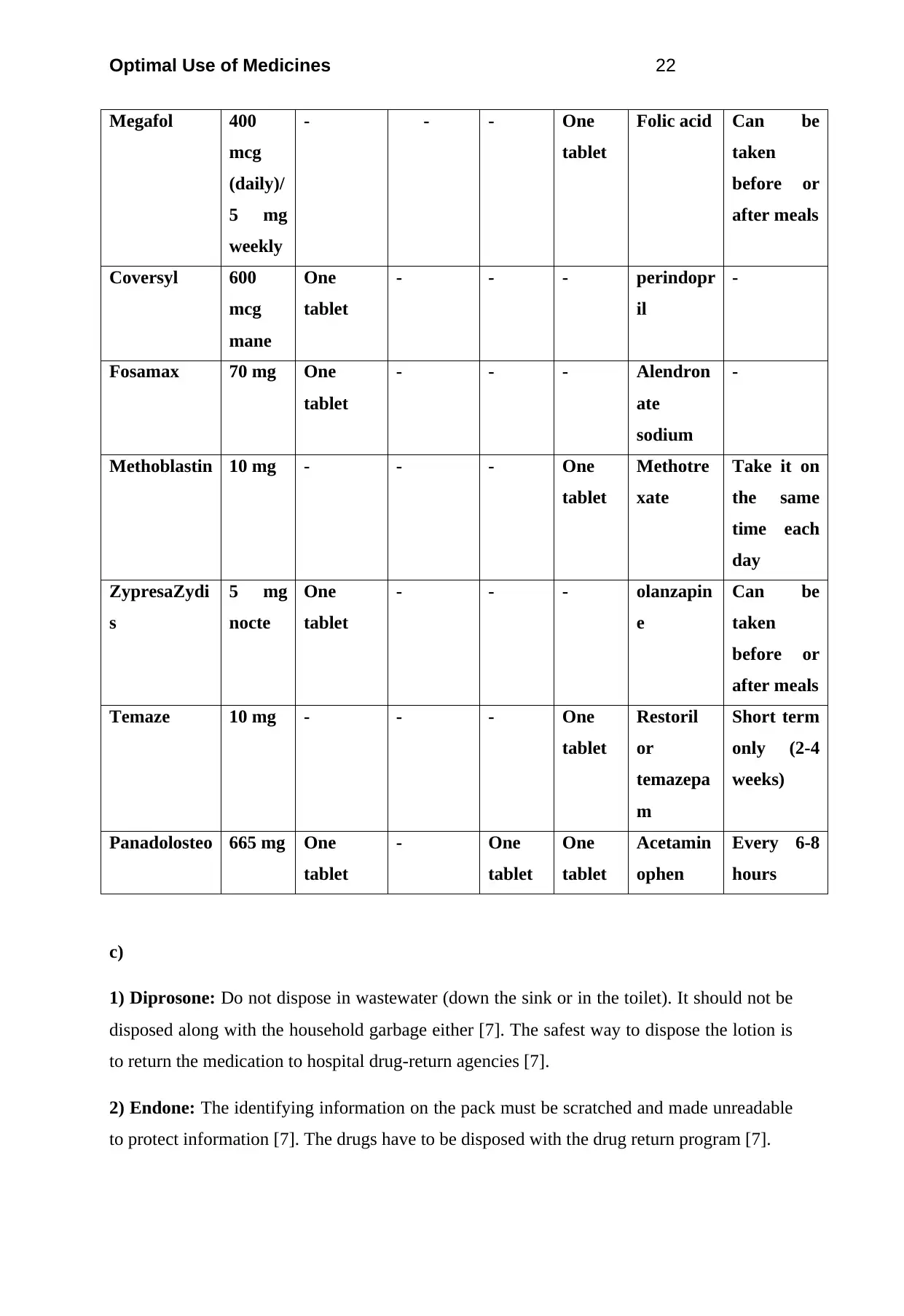
Optimal Use of Medicines 22
Megafol 400
mcg
(daily)/
5 mg
weekly
- - - One
tablet
Folic acid Can be
taken
before or
after meals
Coversyl 600
mcg
mane
One
tablet
- - - perindopr
il
-
Fosamax 70 mg One
tablet
- - - Alendron
ate
sodium
-
Methoblastin 10 mg - - - One
tablet
Methotre
xate
Take it on
the same
time each
day
ZypresaZydi
s
5 mg
nocte
One
tablet
- - - olanzapin
e
Can be
taken
before or
after meals
Temaze 10 mg - - - One
tablet
Restoril
or
temazepa
m
Short term
only (2-4
weeks)
Panadolosteo 665 mg One
tablet
- One
tablet
One
tablet
Acetamin
ophen
Every 6-8
hours
c)
1) Diprosone: Do not dispose in wastewater (down the sink or in the toilet). It should not be
disposed along with the household garbage either [7]. The safest way to dispose the lotion is
to return the medication to hospital drug-return agencies [7].
2) Endone: The identifying information on the pack must be scratched and made unreadable
to protect information [7]. The drugs have to be disposed with the drug return program [7].
Megafol 400
mcg
(daily)/
5 mg
weekly
- - - One
tablet
Folic acid Can be
taken
before or
after meals
Coversyl 600
mcg
mane
One
tablet
- - - perindopr
il
-
Fosamax 70 mg One
tablet
- - - Alendron
ate
sodium
-
Methoblastin 10 mg - - - One
tablet
Methotre
xate
Take it on
the same
time each
day
ZypresaZydi
s
5 mg
nocte
One
tablet
- - - olanzapin
e
Can be
taken
before or
after meals
Temaze 10 mg - - - One
tablet
Restoril
or
temazepa
m
Short term
only (2-4
weeks)
Panadolosteo 665 mg One
tablet
- One
tablet
One
tablet
Acetamin
ophen
Every 6-8
hours
c)
1) Diprosone: Do not dispose in wastewater (down the sink or in the toilet). It should not be
disposed along with the household garbage either [7]. The safest way to dispose the lotion is
to return the medication to hospital drug-return agencies [7].
2) Endone: The identifying information on the pack must be scratched and made unreadable
to protect information [7]. The drugs have to be disposed with the drug return program [7].
Secure Best Marks with AI Grader
Need help grading? Try our AI Grader for instant feedback on your assignments.
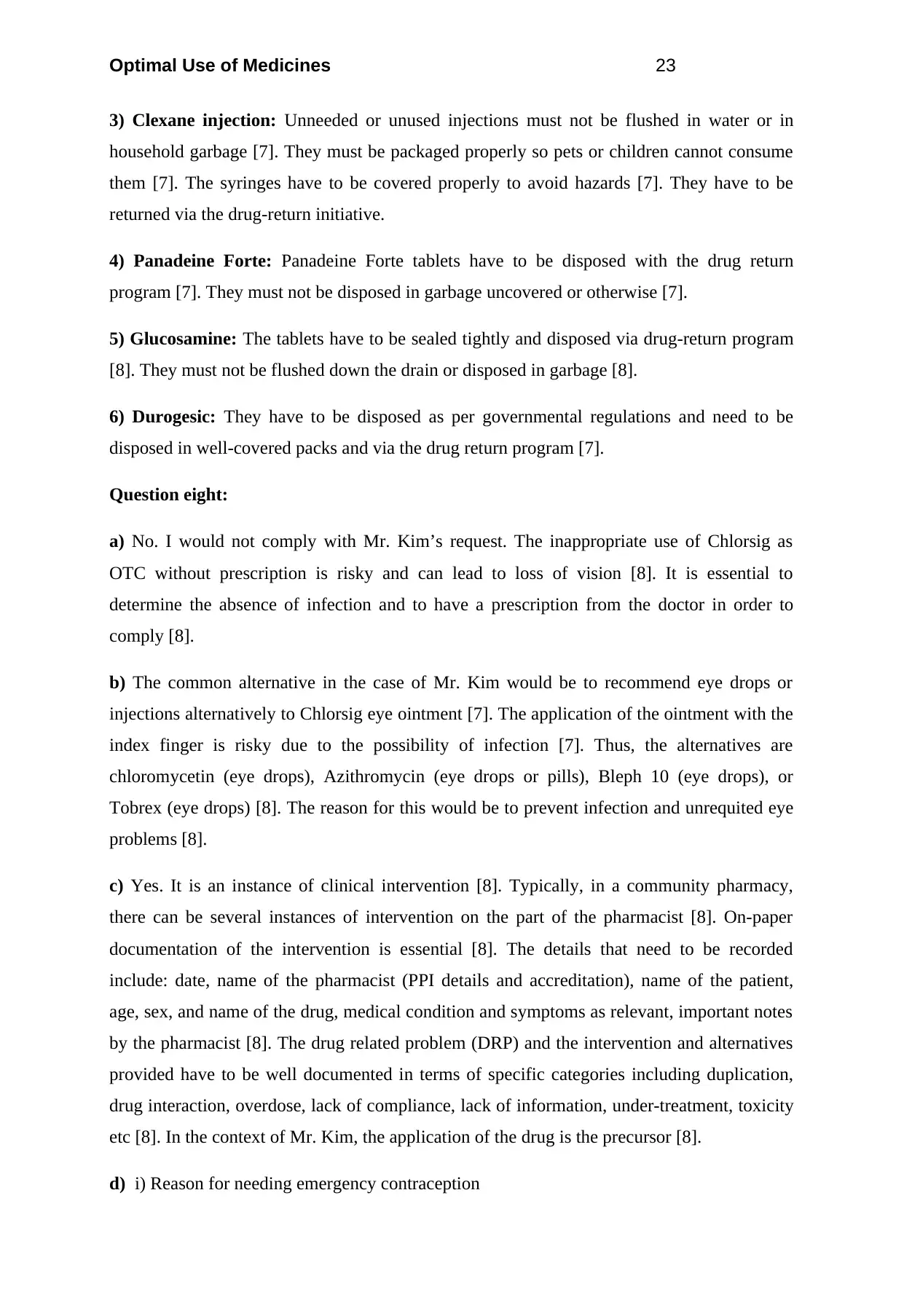
Optimal Use of Medicines 23
3) Clexane injection: Unneeded or unused injections must not be flushed in water or in
household garbage [7]. They must be packaged properly so pets or children cannot consume
them [7]. The syringes have to be covered properly to avoid hazards [7]. They have to be
returned via the drug-return initiative.
4) Panadeine Forte: Panadeine Forte tablets have to be disposed with the drug return
program [7]. They must not be disposed in garbage uncovered or otherwise [7].
5) Glucosamine: The tablets have to be sealed tightly and disposed via drug-return program
[8]. They must not be flushed down the drain or disposed in garbage [8].
6) Durogesic: They have to be disposed as per governmental regulations and need to be
disposed in well-covered packs and via the drug return program [7].
Question eight:
a) No. I would not comply with Mr. Kim’s request. The inappropriate use of Chlorsig as
OTC without prescription is risky and can lead to loss of vision [8]. It is essential to
determine the absence of infection and to have a prescription from the doctor in order to
comply [8].
b) The common alternative in the case of Mr. Kim would be to recommend eye drops or
injections alternatively to Chlorsig eye ointment [7]. The application of the ointment with the
index finger is risky due to the possibility of infection [7]. Thus, the alternatives are
chloromycetin (eye drops), Azithromycin (eye drops or pills), Bleph 10 (eye drops), or
Tobrex (eye drops) [8]. The reason for this would be to prevent infection and unrequited eye
problems [8].
c) Yes. It is an instance of clinical intervention [8]. Typically, in a community pharmacy,
there can be several instances of intervention on the part of the pharmacist [8]. On-paper
documentation of the intervention is essential [8]. The details that need to be recorded
include: date, name of the pharmacist (PPI details and accreditation), name of the patient,
age, sex, and name of the drug, medical condition and symptoms as relevant, important notes
by the pharmacist [8]. The drug related problem (DRP) and the intervention and alternatives
provided have to be well documented in terms of specific categories including duplication,
drug interaction, overdose, lack of compliance, lack of information, under-treatment, toxicity
etc [8]. In the context of Mr. Kim, the application of the drug is the precursor [8].
d) i) Reason for needing emergency contraception
3) Clexane injection: Unneeded or unused injections must not be flushed in water or in
household garbage [7]. They must be packaged properly so pets or children cannot consume
them [7]. The syringes have to be covered properly to avoid hazards [7]. They have to be
returned via the drug-return initiative.
4) Panadeine Forte: Panadeine Forte tablets have to be disposed with the drug return
program [7]. They must not be disposed in garbage uncovered or otherwise [7].
5) Glucosamine: The tablets have to be sealed tightly and disposed via drug-return program
[8]. They must not be flushed down the drain or disposed in garbage [8].
6) Durogesic: They have to be disposed as per governmental regulations and need to be
disposed in well-covered packs and via the drug return program [7].
Question eight:
a) No. I would not comply with Mr. Kim’s request. The inappropriate use of Chlorsig as
OTC without prescription is risky and can lead to loss of vision [8]. It is essential to
determine the absence of infection and to have a prescription from the doctor in order to
comply [8].
b) The common alternative in the case of Mr. Kim would be to recommend eye drops or
injections alternatively to Chlorsig eye ointment [7]. The application of the ointment with the
index finger is risky due to the possibility of infection [7]. Thus, the alternatives are
chloromycetin (eye drops), Azithromycin (eye drops or pills), Bleph 10 (eye drops), or
Tobrex (eye drops) [8]. The reason for this would be to prevent infection and unrequited eye
problems [8].
c) Yes. It is an instance of clinical intervention [8]. Typically, in a community pharmacy,
there can be several instances of intervention on the part of the pharmacist [8]. On-paper
documentation of the intervention is essential [8]. The details that need to be recorded
include: date, name of the pharmacist (PPI details and accreditation), name of the patient,
age, sex, and name of the drug, medical condition and symptoms as relevant, important notes
by the pharmacist [8]. The drug related problem (DRP) and the intervention and alternatives
provided have to be well documented in terms of specific categories including duplication,
drug interaction, overdose, lack of compliance, lack of information, under-treatment, toxicity
etc [8]. In the context of Mr. Kim, the application of the drug is the precursor [8].
d) i) Reason for needing emergency contraception
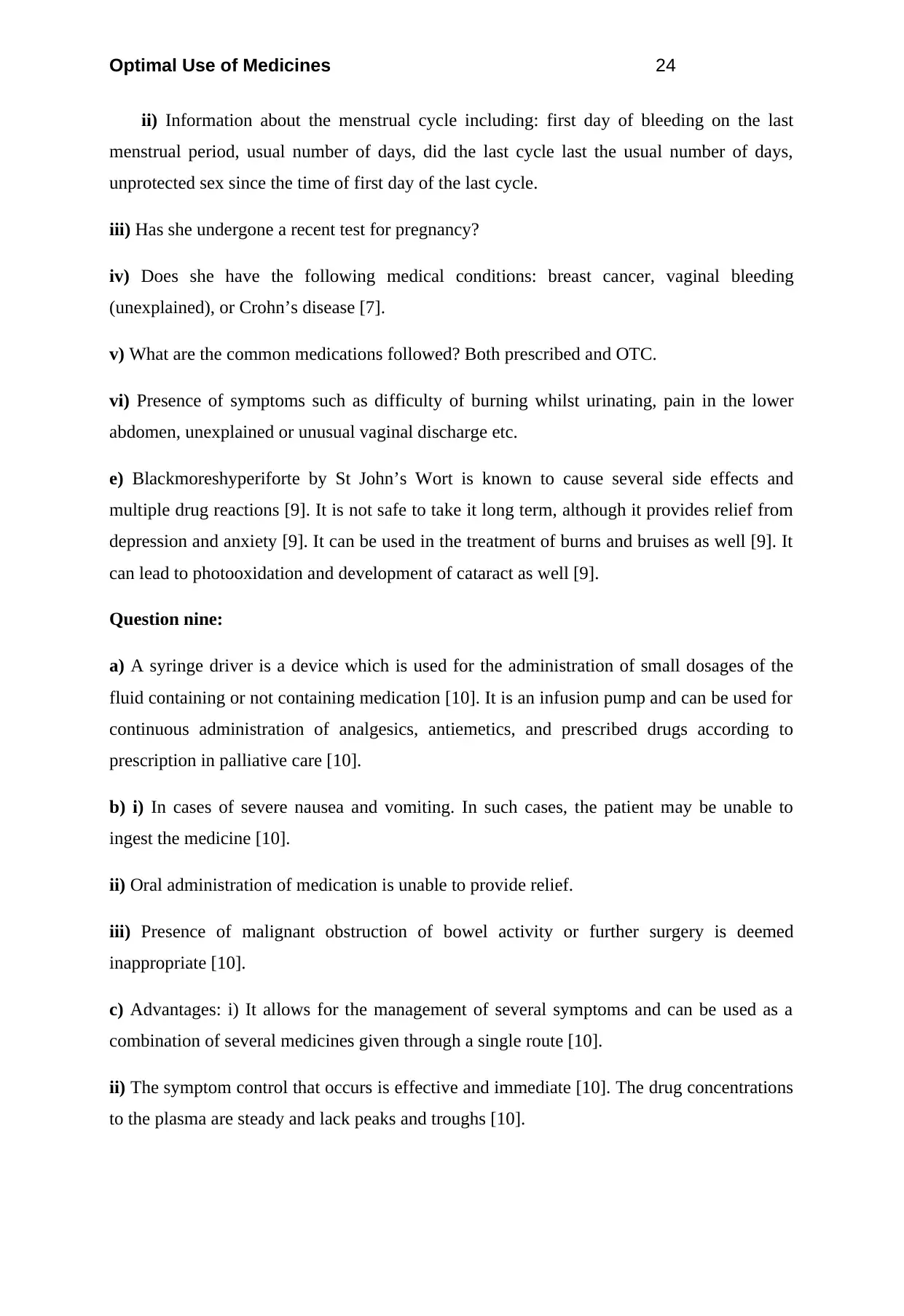
Optimal Use of Medicines 24
ii) Information about the menstrual cycle including: first day of bleeding on the last
menstrual period, usual number of days, did the last cycle last the usual number of days,
unprotected sex since the time of first day of the last cycle.
iii) Has she undergone a recent test for pregnancy?
iv) Does she have the following medical conditions: breast cancer, vaginal bleeding
(unexplained), or Crohn’s disease [7].
v) What are the common medications followed? Both prescribed and OTC.
vi) Presence of symptoms such as difficulty of burning whilst urinating, pain in the lower
abdomen, unexplained or unusual vaginal discharge etc.
e) Blackmoreshyperiforte by St John’s Wort is known to cause several side effects and
multiple drug reactions [9]. It is not safe to take it long term, although it provides relief from
depression and anxiety [9]. It can be used in the treatment of burns and bruises as well [9]. It
can lead to photooxidation and development of cataract as well [9].
Question nine:
a) A syringe driver is a device which is used for the administration of small dosages of the
fluid containing or not containing medication [10]. It is an infusion pump and can be used for
continuous administration of analgesics, antiemetics, and prescribed drugs according to
prescription in palliative care [10].
b) i) In cases of severe nausea and vomiting. In such cases, the patient may be unable to
ingest the medicine [10].
ii) Oral administration of medication is unable to provide relief.
iii) Presence of malignant obstruction of bowel activity or further surgery is deemed
inappropriate [10].
c) Advantages: i) It allows for the management of several symptoms and can be used as a
combination of several medicines given through a single route [10].
ii) The symptom control that occurs is effective and immediate [10]. The drug concentrations
to the plasma are steady and lack peaks and troughs [10].
ii) Information about the menstrual cycle including: first day of bleeding on the last
menstrual period, usual number of days, did the last cycle last the usual number of days,
unprotected sex since the time of first day of the last cycle.
iii) Has she undergone a recent test for pregnancy?
iv) Does she have the following medical conditions: breast cancer, vaginal bleeding
(unexplained), or Crohn’s disease [7].
v) What are the common medications followed? Both prescribed and OTC.
vi) Presence of symptoms such as difficulty of burning whilst urinating, pain in the lower
abdomen, unexplained or unusual vaginal discharge etc.
e) Blackmoreshyperiforte by St John’s Wort is known to cause several side effects and
multiple drug reactions [9]. It is not safe to take it long term, although it provides relief from
depression and anxiety [9]. It can be used in the treatment of burns and bruises as well [9]. It
can lead to photooxidation and development of cataract as well [9].
Question nine:
a) A syringe driver is a device which is used for the administration of small dosages of the
fluid containing or not containing medication [10]. It is an infusion pump and can be used for
continuous administration of analgesics, antiemetics, and prescribed drugs according to
prescription in palliative care [10].
b) i) In cases of severe nausea and vomiting. In such cases, the patient may be unable to
ingest the medicine [10].
ii) Oral administration of medication is unable to provide relief.
iii) Presence of malignant obstruction of bowel activity or further surgery is deemed
inappropriate [10].
c) Advantages: i) It allows for the management of several symptoms and can be used as a
combination of several medicines given through a single route [10].
ii) The symptom control that occurs is effective and immediate [10]. The drug concentrations
to the plasma are steady and lack peaks and troughs [10].
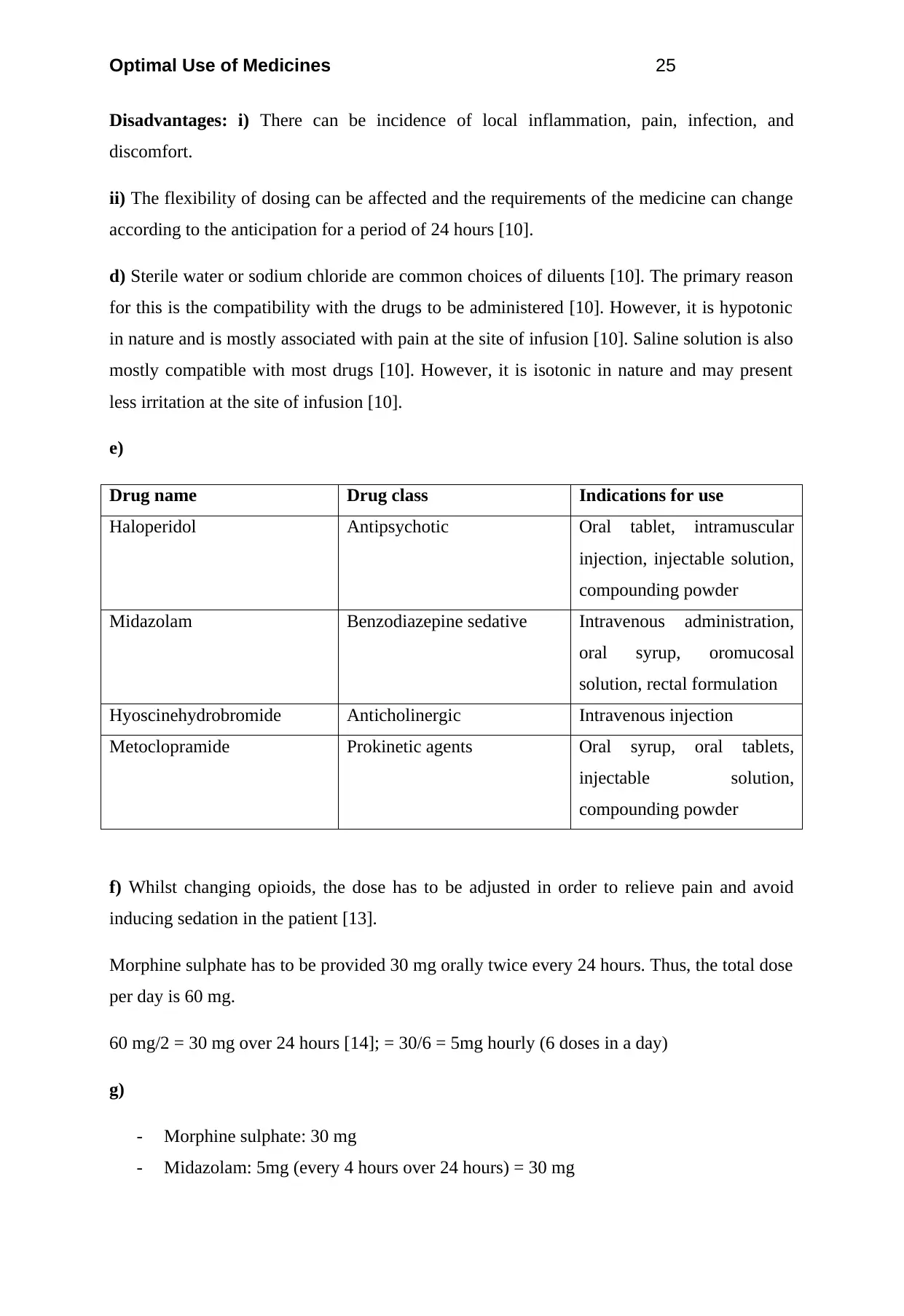
Optimal Use of Medicines 25
Disadvantages: i) There can be incidence of local inflammation, pain, infection, and
discomfort.
ii) The flexibility of dosing can be affected and the requirements of the medicine can change
according to the anticipation for a period of 24 hours [10].
d) Sterile water or sodium chloride are common choices of diluents [10]. The primary reason
for this is the compatibility with the drugs to be administered [10]. However, it is hypotonic
in nature and is mostly associated with pain at the site of infusion [10]. Saline solution is also
mostly compatible with most drugs [10]. However, it is isotonic in nature and may present
less irritation at the site of infusion [10].
e)
Drug name Drug class Indications for use
Haloperidol Antipsychotic Oral tablet, intramuscular
injection, injectable solution,
compounding powder
Midazolam Benzodiazepine sedative Intravenous administration,
oral syrup, oromucosal
solution, rectal formulation
Hyoscinehydrobromide Anticholinergic Intravenous injection
Metoclopramide Prokinetic agents Oral syrup, oral tablets,
injectable solution,
compounding powder
f) Whilst changing opioids, the dose has to be adjusted in order to relieve pain and avoid
inducing sedation in the patient [13].
Morphine sulphate has to be provided 30 mg orally twice every 24 hours. Thus, the total dose
per day is 60 mg.
60 mg/2 = 30 mg over 24 hours [14]; = 30/6 = 5mg hourly (6 doses in a day)
g)
- Morphine sulphate: 30 mg
- Midazolam: 5mg (every 4 hours over 24 hours) = 30 mg
Disadvantages: i) There can be incidence of local inflammation, pain, infection, and
discomfort.
ii) The flexibility of dosing can be affected and the requirements of the medicine can change
according to the anticipation for a period of 24 hours [10].
d) Sterile water or sodium chloride are common choices of diluents [10]. The primary reason
for this is the compatibility with the drugs to be administered [10]. However, it is hypotonic
in nature and is mostly associated with pain at the site of infusion [10]. Saline solution is also
mostly compatible with most drugs [10]. However, it is isotonic in nature and may present
less irritation at the site of infusion [10].
e)
Drug name Drug class Indications for use
Haloperidol Antipsychotic Oral tablet, intramuscular
injection, injectable solution,
compounding powder
Midazolam Benzodiazepine sedative Intravenous administration,
oral syrup, oromucosal
solution, rectal formulation
Hyoscinehydrobromide Anticholinergic Intravenous injection
Metoclopramide Prokinetic agents Oral syrup, oral tablets,
injectable solution,
compounding powder
f) Whilst changing opioids, the dose has to be adjusted in order to relieve pain and avoid
inducing sedation in the patient [13].
Morphine sulphate has to be provided 30 mg orally twice every 24 hours. Thus, the total dose
per day is 60 mg.
60 mg/2 = 30 mg over 24 hours [14]; = 30/6 = 5mg hourly (6 doses in a day)
g)
- Morphine sulphate: 30 mg
- Midazolam: 5mg (every 4 hours over 24 hours) = 30 mg
Paraphrase This Document
Need a fresh take? Get an instant paraphrase of this document with our AI Paraphraser
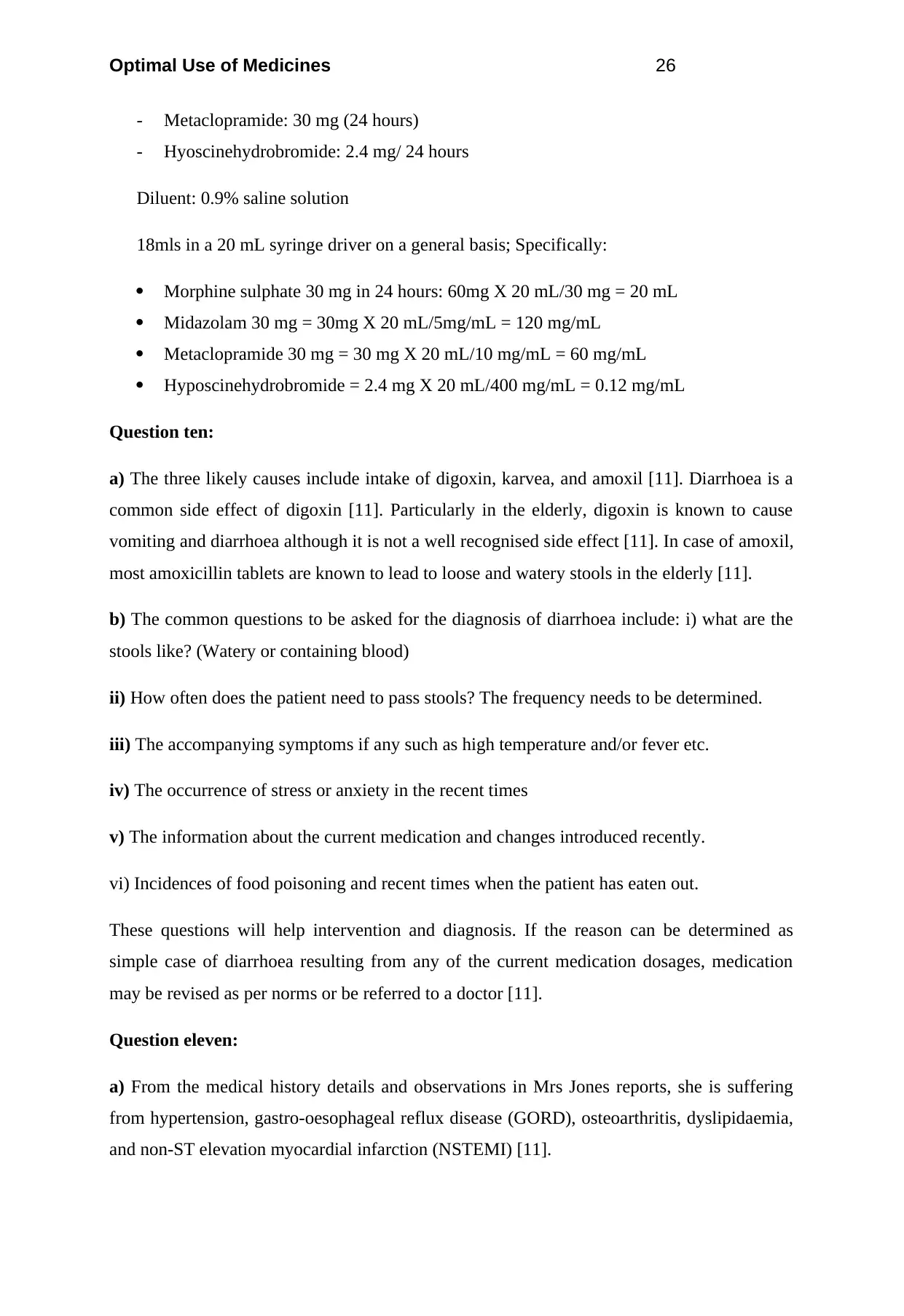
Optimal Use of Medicines 26
- Metaclopramide: 30 mg (24 hours)
- Hyoscinehydrobromide: 2.4 mg/ 24 hours
Diluent: 0.9% saline solution
18mls in a 20 mL syringe driver on a general basis; Specifically:
Morphine sulphate 30 mg in 24 hours: 60mg X 20 mL/30 mg = 20 mL
Midazolam 30 mg = 30mg X 20 mL/5mg/mL = 120 mg/mL
Metaclopramide 30 mg = 30 mg X 20 mL/10 mg/mL = 60 mg/mL
Hyposcinehydrobromide = 2.4 mg X 20 mL/400 mg/mL = 0.12 mg/mL
Question ten:
a) The three likely causes include intake of digoxin, karvea, and amoxil [11]. Diarrhoea is a
common side effect of digoxin [11]. Particularly in the elderly, digoxin is known to cause
vomiting and diarrhoea although it is not a well recognised side effect [11]. In case of amoxil,
most amoxicillin tablets are known to lead to loose and watery stools in the elderly [11].
b) The common questions to be asked for the diagnosis of diarrhoea include: i) what are the
stools like? (Watery or containing blood)
ii) How often does the patient need to pass stools? The frequency needs to be determined.
iii) The accompanying symptoms if any such as high temperature and/or fever etc.
iv) The occurrence of stress or anxiety in the recent times
v) The information about the current medication and changes introduced recently.
vi) Incidences of food poisoning and recent times when the patient has eaten out.
These questions will help intervention and diagnosis. If the reason can be determined as
simple case of diarrhoea resulting from any of the current medication dosages, medication
may be revised as per norms or be referred to a doctor [11].
Question eleven:
a) From the medical history details and observations in Mrs Jones reports, she is suffering
from hypertension, gastro-oesophageal reflux disease (GORD), osteoarthritis, dyslipidaemia,
and non-ST elevation myocardial infarction (NSTEMI) [11].
- Metaclopramide: 30 mg (24 hours)
- Hyoscinehydrobromide: 2.4 mg/ 24 hours
Diluent: 0.9% saline solution
18mls in a 20 mL syringe driver on a general basis; Specifically:
Morphine sulphate 30 mg in 24 hours: 60mg X 20 mL/30 mg = 20 mL
Midazolam 30 mg = 30mg X 20 mL/5mg/mL = 120 mg/mL
Metaclopramide 30 mg = 30 mg X 20 mL/10 mg/mL = 60 mg/mL
Hyposcinehydrobromide = 2.4 mg X 20 mL/400 mg/mL = 0.12 mg/mL
Question ten:
a) The three likely causes include intake of digoxin, karvea, and amoxil [11]. Diarrhoea is a
common side effect of digoxin [11]. Particularly in the elderly, digoxin is known to cause
vomiting and diarrhoea although it is not a well recognised side effect [11]. In case of amoxil,
most amoxicillin tablets are known to lead to loose and watery stools in the elderly [11].
b) The common questions to be asked for the diagnosis of diarrhoea include: i) what are the
stools like? (Watery or containing blood)
ii) How often does the patient need to pass stools? The frequency needs to be determined.
iii) The accompanying symptoms if any such as high temperature and/or fever etc.
iv) The occurrence of stress or anxiety in the recent times
v) The information about the current medication and changes introduced recently.
vi) Incidences of food poisoning and recent times when the patient has eaten out.
These questions will help intervention and diagnosis. If the reason can be determined as
simple case of diarrhoea resulting from any of the current medication dosages, medication
may be revised as per norms or be referred to a doctor [11].
Question eleven:
a) From the medical history details and observations in Mrs Jones reports, she is suffering
from hypertension, gastro-oesophageal reflux disease (GORD), osteoarthritis, dyslipidaemia,
and non-ST elevation myocardial infarction (NSTEMI) [11].
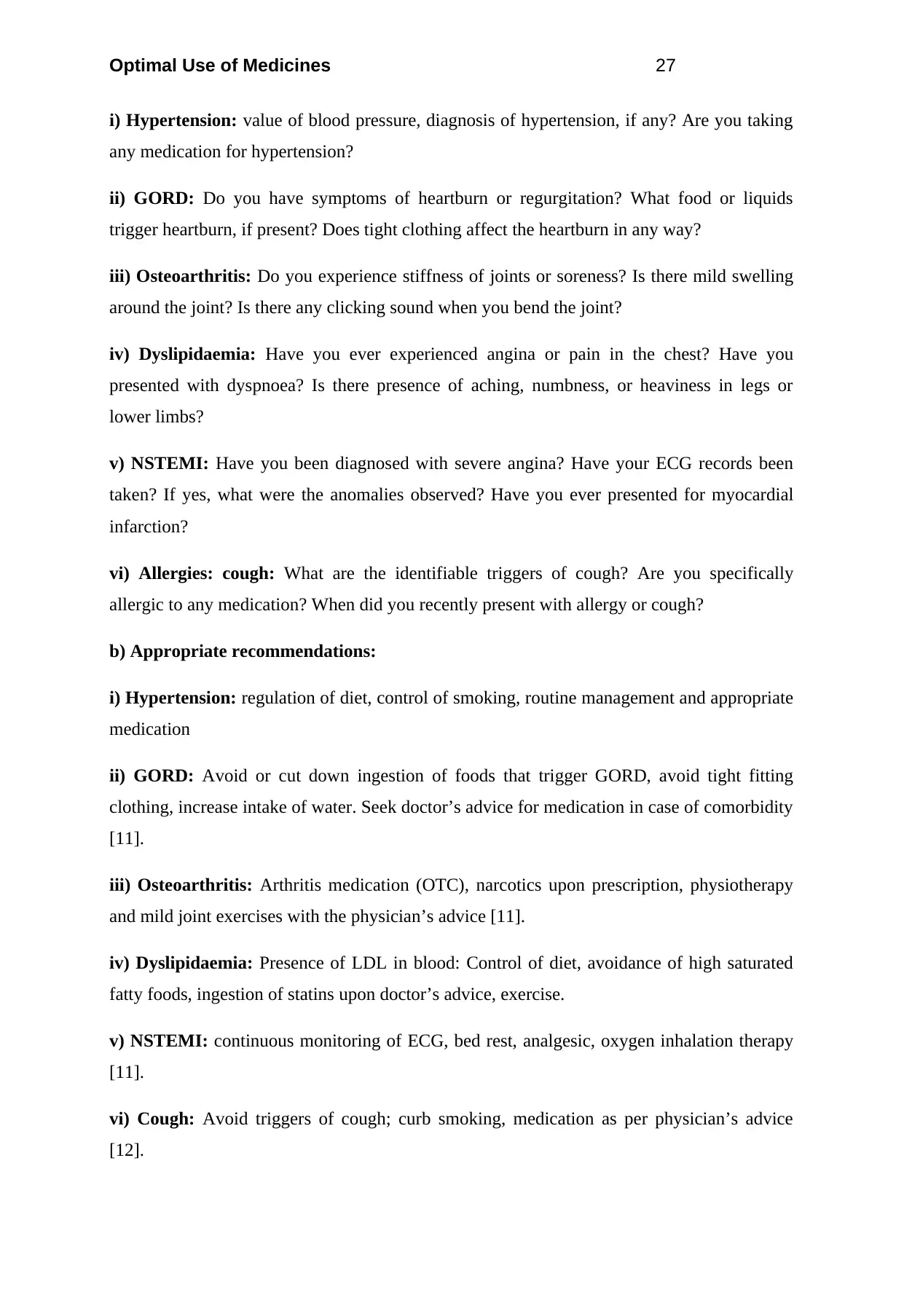
Optimal Use of Medicines 27
i) Hypertension: value of blood pressure, diagnosis of hypertension, if any? Are you taking
any medication for hypertension?
ii) GORD: Do you have symptoms of heartburn or regurgitation? What food or liquids
trigger heartburn, if present? Does tight clothing affect the heartburn in any way?
iii) Osteoarthritis: Do you experience stiffness of joints or soreness? Is there mild swelling
around the joint? Is there any clicking sound when you bend the joint?
iv) Dyslipidaemia: Have you ever experienced angina or pain in the chest? Have you
presented with dyspnoea? Is there presence of aching, numbness, or heaviness in legs or
lower limbs?
v) NSTEMI: Have you been diagnosed with severe angina? Have your ECG records been
taken? If yes, what were the anomalies observed? Have you ever presented for myocardial
infarction?
vi) Allergies: cough: What are the identifiable triggers of cough? Are you specifically
allergic to any medication? When did you recently present with allergy or cough?
b) Appropriate recommendations:
i) Hypertension: regulation of diet, control of smoking, routine management and appropriate
medication
ii) GORD: Avoid or cut down ingestion of foods that trigger GORD, avoid tight fitting
clothing, increase intake of water. Seek doctor’s advice for medication in case of comorbidity
[11].
iii) Osteoarthritis: Arthritis medication (OTC), narcotics upon prescription, physiotherapy
and mild joint exercises with the physician’s advice [11].
iv) Dyslipidaemia: Presence of LDL in blood: Control of diet, avoidance of high saturated
fatty foods, ingestion of statins upon doctor’s advice, exercise.
v) NSTEMI: continuous monitoring of ECG, bed rest, analgesic, oxygen inhalation therapy
[11].
vi) Cough: Avoid triggers of cough; curb smoking, medication as per physician’s advice
[12].
i) Hypertension: value of blood pressure, diagnosis of hypertension, if any? Are you taking
any medication for hypertension?
ii) GORD: Do you have symptoms of heartburn or regurgitation? What food or liquids
trigger heartburn, if present? Does tight clothing affect the heartburn in any way?
iii) Osteoarthritis: Do you experience stiffness of joints or soreness? Is there mild swelling
around the joint? Is there any clicking sound when you bend the joint?
iv) Dyslipidaemia: Have you ever experienced angina or pain in the chest? Have you
presented with dyspnoea? Is there presence of aching, numbness, or heaviness in legs or
lower limbs?
v) NSTEMI: Have you been diagnosed with severe angina? Have your ECG records been
taken? If yes, what were the anomalies observed? Have you ever presented for myocardial
infarction?
vi) Allergies: cough: What are the identifiable triggers of cough? Are you specifically
allergic to any medication? When did you recently present with allergy or cough?
b) Appropriate recommendations:
i) Hypertension: regulation of diet, control of smoking, routine management and appropriate
medication
ii) GORD: Avoid or cut down ingestion of foods that trigger GORD, avoid tight fitting
clothing, increase intake of water. Seek doctor’s advice for medication in case of comorbidity
[11].
iii) Osteoarthritis: Arthritis medication (OTC), narcotics upon prescription, physiotherapy
and mild joint exercises with the physician’s advice [11].
iv) Dyslipidaemia: Presence of LDL in blood: Control of diet, avoidance of high saturated
fatty foods, ingestion of statins upon doctor’s advice, exercise.
v) NSTEMI: continuous monitoring of ECG, bed rest, analgesic, oxygen inhalation therapy
[11].
vi) Cough: Avoid triggers of cough; curb smoking, medication as per physician’s advice
[12].
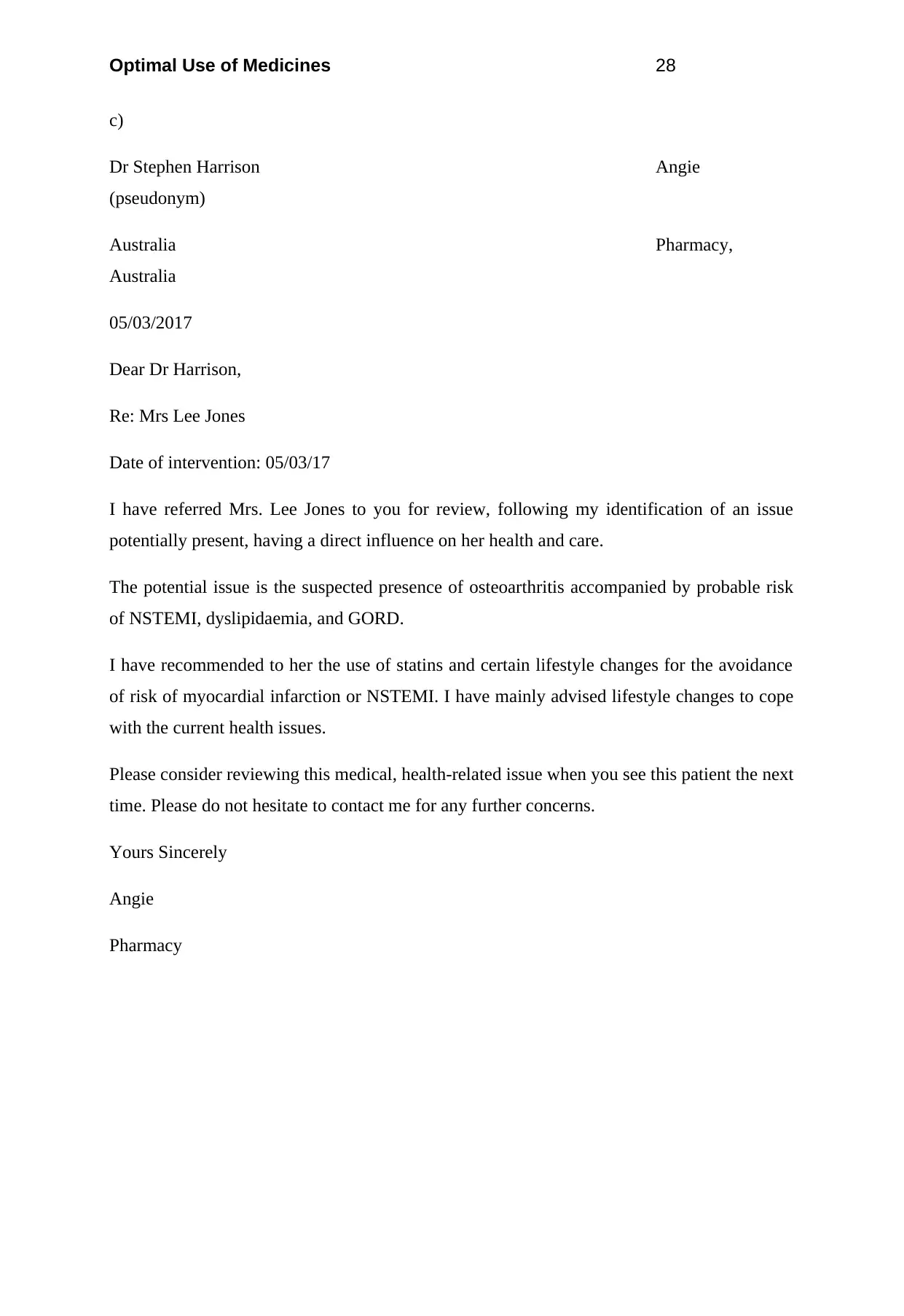
Optimal Use of Medicines 28
c)
Dr Stephen Harrison Angie
(pseudonym)
Australia Pharmacy,
Australia
05/03/2017
Dear Dr Harrison,
Re: Mrs Lee Jones
Date of intervention: 05/03/17
I have referred Mrs. Lee Jones to you for review, following my identification of an issue
potentially present, having a direct influence on her health and care.
The potential issue is the suspected presence of osteoarthritis accompanied by probable risk
of NSTEMI, dyslipidaemia, and GORD.
I have recommended to her the use of statins and certain lifestyle changes for the avoidance
of risk of myocardial infarction or NSTEMI. I have mainly advised lifestyle changes to cope
with the current health issues.
Please consider reviewing this medical, health-related issue when you see this patient the next
time. Please do not hesitate to contact me for any further concerns.
Yours Sincerely
Angie
Pharmacy
c)
Dr Stephen Harrison Angie
(pseudonym)
Australia Pharmacy,
Australia
05/03/2017
Dear Dr Harrison,
Re: Mrs Lee Jones
Date of intervention: 05/03/17
I have referred Mrs. Lee Jones to you for review, following my identification of an issue
potentially present, having a direct influence on her health and care.
The potential issue is the suspected presence of osteoarthritis accompanied by probable risk
of NSTEMI, dyslipidaemia, and GORD.
I have recommended to her the use of statins and certain lifestyle changes for the avoidance
of risk of myocardial infarction or NSTEMI. I have mainly advised lifestyle changes to cope
with the current health issues.
Please consider reviewing this medical, health-related issue when you see this patient the next
time. Please do not hesitate to contact me for any further concerns.
Yours Sincerely
Angie
Pharmacy
Secure Best Marks with AI Grader
Need help grading? Try our AI Grader for instant feedback on your assignments.
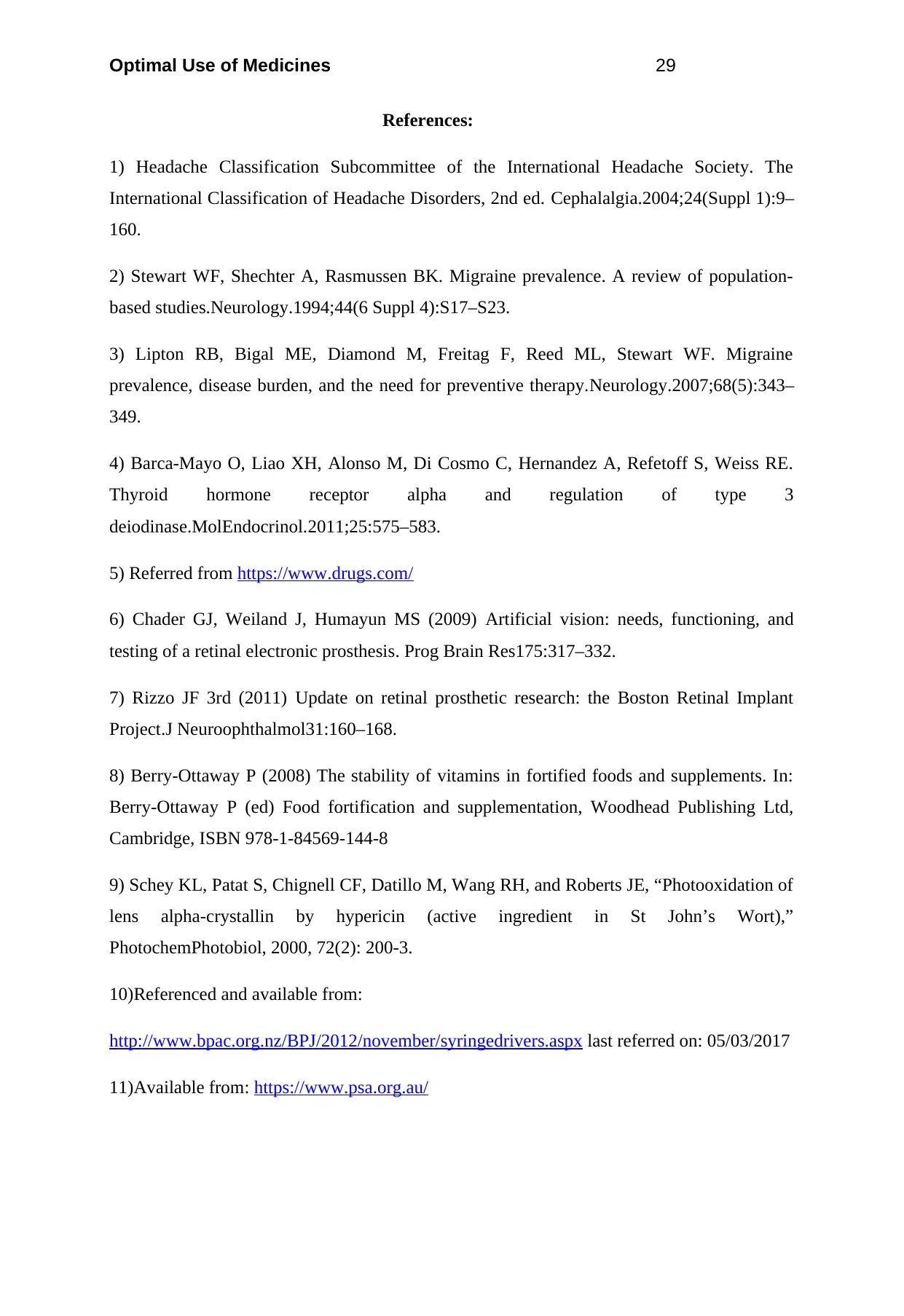
Optimal Use of Medicines 29
References:
1) Headache Classification Subcommittee of the International Headache Society. The
International Classification of Headache Disorders, 2nd ed. Cephalalgia.2004;24(Suppl 1):9–
160.
2) Stewart WF, Shechter A, Rasmussen BK. Migraine prevalence. A review of population-
based studies.Neurology.1994;44(6 Suppl 4):S17–S23.
3) Lipton RB, Bigal ME, Diamond M, Freitag F, Reed ML, Stewart WF. Migraine
prevalence, disease burden, and the need for preventive therapy.Neurology.2007;68(5):343–
349.
4) Barca-Mayo O, Liao XH, Alonso M, Di Cosmo C, Hernandez A, Refetoff S, Weiss RE.
Thyroid hormone receptor alpha and regulation of type 3
deiodinase.MolEndocrinol.2011;25:575–583.
5) Referred from https://www.drugs.com/
6) Chader GJ, Weiland J, Humayun MS (2009) Artificial vision: needs, functioning, and
testing of a retinal electronic prosthesis. Prog Brain Res175:317–332.
7) Rizzo JF 3rd (2011) Update on retinal prosthetic research: the Boston Retinal Implant
Project.J Neuroophthalmol31:160–168.
8) Berry-Ottaway P (2008) The stability of vitamins in fortified foods and supplements. In:
Berry-Ottaway P (ed) Food fortification and supplementation, Woodhead Publishing Ltd,
Cambridge, ISBN 978-1-84569-144-8
9) Schey KL, Patat S, Chignell CF, Datillo M, Wang RH, and Roberts JE, “Photooxidation of
lens alpha-crystallin by hypericin (active ingredient in St John’s Wort),”
PhotochemPhotobiol, 2000, 72(2): 200-3.
10)Referenced and available from:
http://www.bpac.org.nz/BPJ/2012/november/syringedrivers.aspx last referred on: 05/03/2017
11)Available from: https://www.psa.org.au/
References:
1) Headache Classification Subcommittee of the International Headache Society. The
International Classification of Headache Disorders, 2nd ed. Cephalalgia.2004;24(Suppl 1):9–
160.
2) Stewart WF, Shechter A, Rasmussen BK. Migraine prevalence. A review of population-
based studies.Neurology.1994;44(6 Suppl 4):S17–S23.
3) Lipton RB, Bigal ME, Diamond M, Freitag F, Reed ML, Stewart WF. Migraine
prevalence, disease burden, and the need for preventive therapy.Neurology.2007;68(5):343–
349.
4) Barca-Mayo O, Liao XH, Alonso M, Di Cosmo C, Hernandez A, Refetoff S, Weiss RE.
Thyroid hormone receptor alpha and regulation of type 3
deiodinase.MolEndocrinol.2011;25:575–583.
5) Referred from https://www.drugs.com/
6) Chader GJ, Weiland J, Humayun MS (2009) Artificial vision: needs, functioning, and
testing of a retinal electronic prosthesis. Prog Brain Res175:317–332.
7) Rizzo JF 3rd (2011) Update on retinal prosthetic research: the Boston Retinal Implant
Project.J Neuroophthalmol31:160–168.
8) Berry-Ottaway P (2008) The stability of vitamins in fortified foods and supplements. In:
Berry-Ottaway P (ed) Food fortification and supplementation, Woodhead Publishing Ltd,
Cambridge, ISBN 978-1-84569-144-8
9) Schey KL, Patat S, Chignell CF, Datillo M, Wang RH, and Roberts JE, “Photooxidation of
lens alpha-crystallin by hypericin (active ingredient in St John’s Wort),”
PhotochemPhotobiol, 2000, 72(2): 200-3.
10)Referenced and available from:
http://www.bpac.org.nz/BPJ/2012/november/syringedrivers.aspx last referred on: 05/03/2017
11)Available from: https://www.psa.org.au/
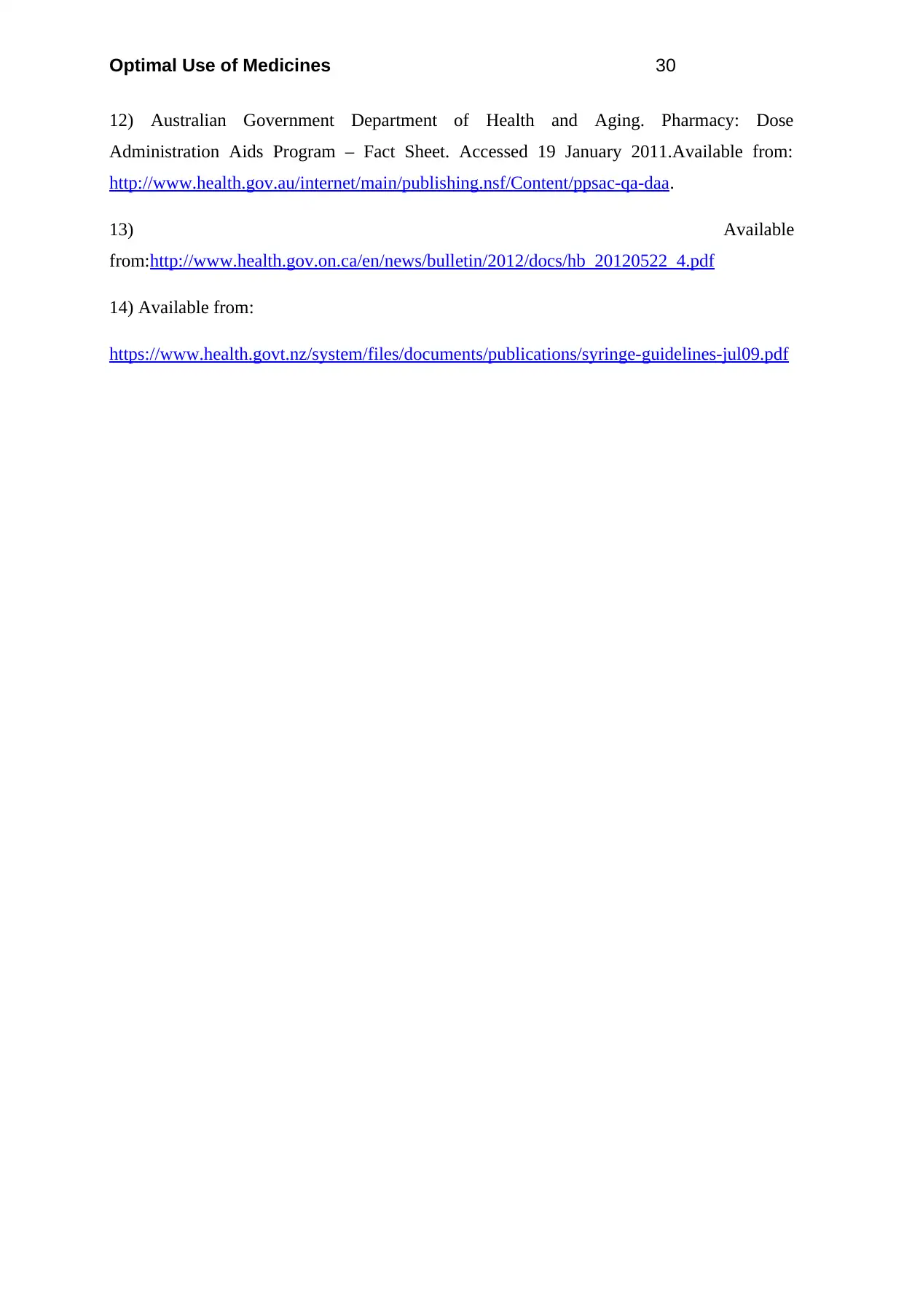
Optimal Use of Medicines 30
12) Australian Government Department of Health and Aging. Pharmacy: Dose
Administration Aids Program – Fact Sheet. Accessed 19 January 2011.Available from:
http://www.health.gov.au/internet/main/publishing.nsf/Content/ppsac-qa-daa.
13) Available
from:http://www.health.gov.on.ca/en/news/bulletin/2012/docs/hb_20120522_4.pdf
14) Available from:
https://www.health.govt.nz/system/files/documents/publications/syringe-guidelines-jul09.pdf
12) Australian Government Department of Health and Aging. Pharmacy: Dose
Administration Aids Program – Fact Sheet. Accessed 19 January 2011.Available from:
http://www.health.gov.au/internet/main/publishing.nsf/Content/ppsac-qa-daa.
13) Available
from:http://www.health.gov.on.ca/en/news/bulletin/2012/docs/hb_20120522_4.pdf
14) Available from:
https://www.health.govt.nz/system/files/documents/publications/syringe-guidelines-jul09.pdf
1 out of 30
Your All-in-One AI-Powered Toolkit for Academic Success.
+13062052269
info@desklib.com
Available 24*7 on WhatsApp / Email
![[object Object]](/_next/static/media/star-bottom.7253800d.svg)
Unlock your academic potential
© 2024 | Zucol Services PVT LTD | All rights reserved.